Travelling with Stabilo #21: Orvieto On a Rock 经纬游踪 #21: 奥尔维耶托古城
Travelling with Stabilo #21: Orvieto On a Rock
经纬游踪 #21: 奥尔维耶托古城
Orvieto is a small town on the lying close to border of the Umbria region and the Lazio Region in Central Italy. It is about an hour train ride away from Rome, and it is a popular day trip destination for people living in the Italian Capital. The most striking feature of the town is that it lies on top of a piece of rock, and it is this that earned Orvieto a place in my tightly scheduled itinerary during my Italy trip back in 2016.
奥尔维耶托坐落意大利中部翁布利亚区和拉齐奥区的交界,是一个离罗马只有一个多小时,历史悠久的小城。奥尔维耶托的特别之处在于整个古城建于一块大岩石之上,高高的俯视着翁布利亚的平原。就凭这一点,奥尔维耶托打败了其他小城,成为了我们意大利之旅的第二站。
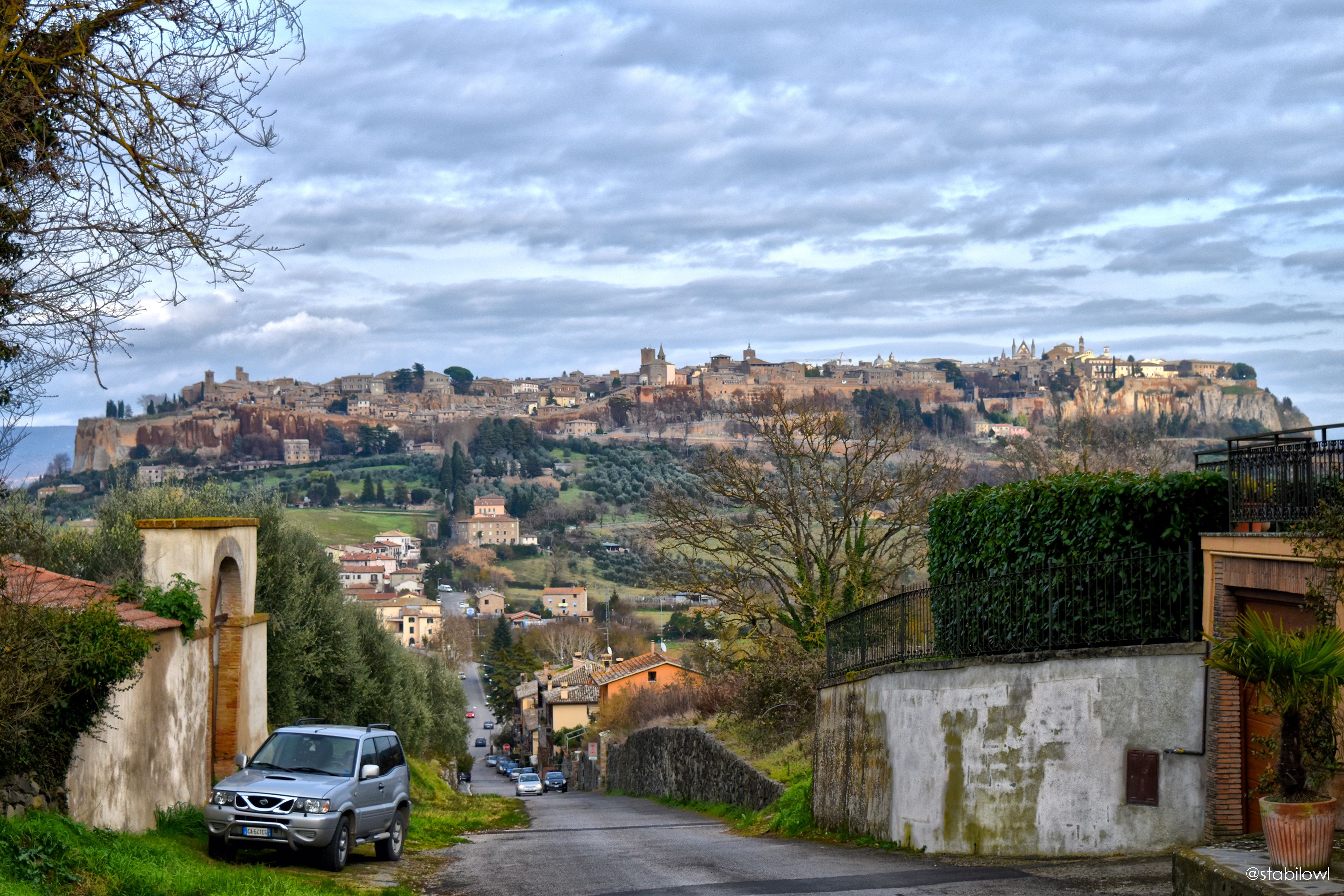
We left Rome in the early morning. There are quite a few trains going north from Rome that stops at Orvieto. After an uneventful ride, we arrived at the Orvieto train station at around 9:30 am in the morning. Right by the train station is the funicular station, and from there, we took the cable car up to the top of the rock where Orvieto sits. There are buses that take travellers from the top of the funicular to the Orvieto Cathedral at the centre of the town. We thought it would be nicer to walk to our bed and breakfast while enjoying the scenes of this old town. Well, the walk was indeed charming, but it was much longer than expected. Orvieto township has kind of an egg shape, and unfortunately it turns out that the funicular station was at one end of the egg, whereas our B&B is on the other end. But we didn’t know that. So we walked. It was still very quiet and there were hardly any people walking along the main street of the town. And it was more like a lane then a street, as it is so narrow that only one car can pass at a time. Two or three stories old brick houses lined the two sides of the cobblestone street, with vines hanging on the side of the wall and flowers displaying on the balconies. Little laneways split off from the main street, and many of them were very picturesque. We stopped quite often to take pictures, as the European small town charm was exactly what it was like in story books. As we walked closer to the centre of the town, we saw more people walking about in the street, minding their business. We also see the clock tower looming high above the other buildings, and displaying the wrong time.
离开罗马那天,我们早早就离开了酒店到达中央火车站。从罗马去奥尔维耶托非常便利,很多向北的火车都会经过奥尔维耶托。我们上了八点的火车,一个多小时后到达了奥尔维耶托火车站,再从火车站旁的缆车站坐缆车上山,抵达在岩石上的奥尔维多古城。其实在山上的缆车站旁可以乘坐小巴到达城中心的大教堂。因为时间尚早,行李也不多,我们就决定不坐小巴而选择步行到我们的民宿。的确,步行让我们可以好好感受古城的风貌。然而,我们低估了我们离民宿的距离。原来奥尔维耶托古城成鹅蛋形,而缆车站和民宿偏偏在鹅蛋的两尖。我们走了好久。沿着主街从西往东走,一路上非常宁静。这条所谓的主街只有一辆车的宽度,跟一条小巷差不多。两三层高的古老砖房一排排的立在鹅卵石路的两旁,墙头挂着绿绿的藤蔓,阳台放满鲜艳的花朵。一条条比主街更狭窄的小巷从主街上向外伸延,每一条都有自己的特色。我们走走停停,用这童话般的欧式小镇为背景拍出美丽的照片。朝着城中心的广场一真走,路上的行人续渐变多。我们远远的看到了耸立在城中心的钟楼,钟上竟然显示着错误的时间。


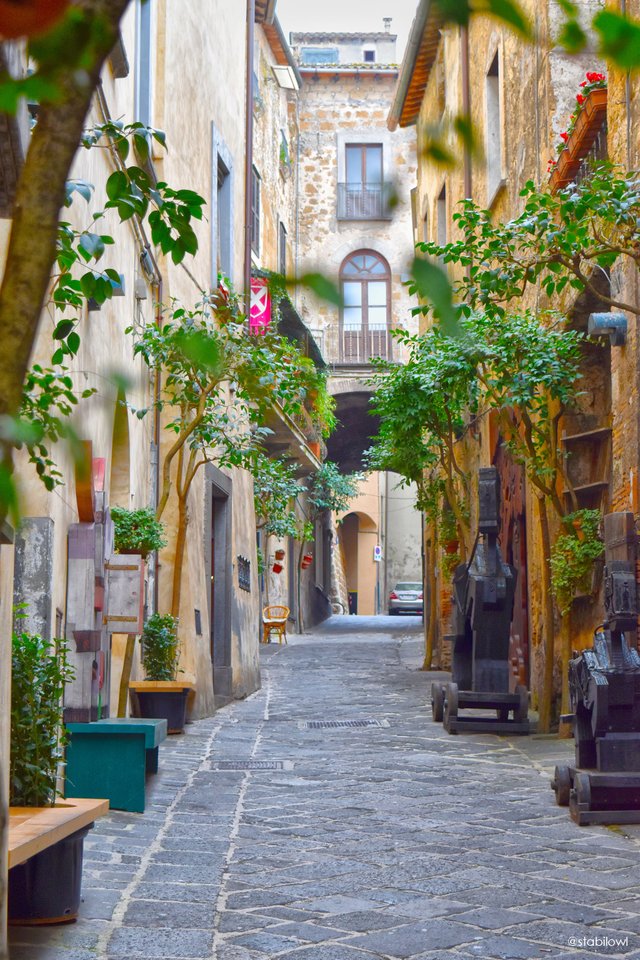
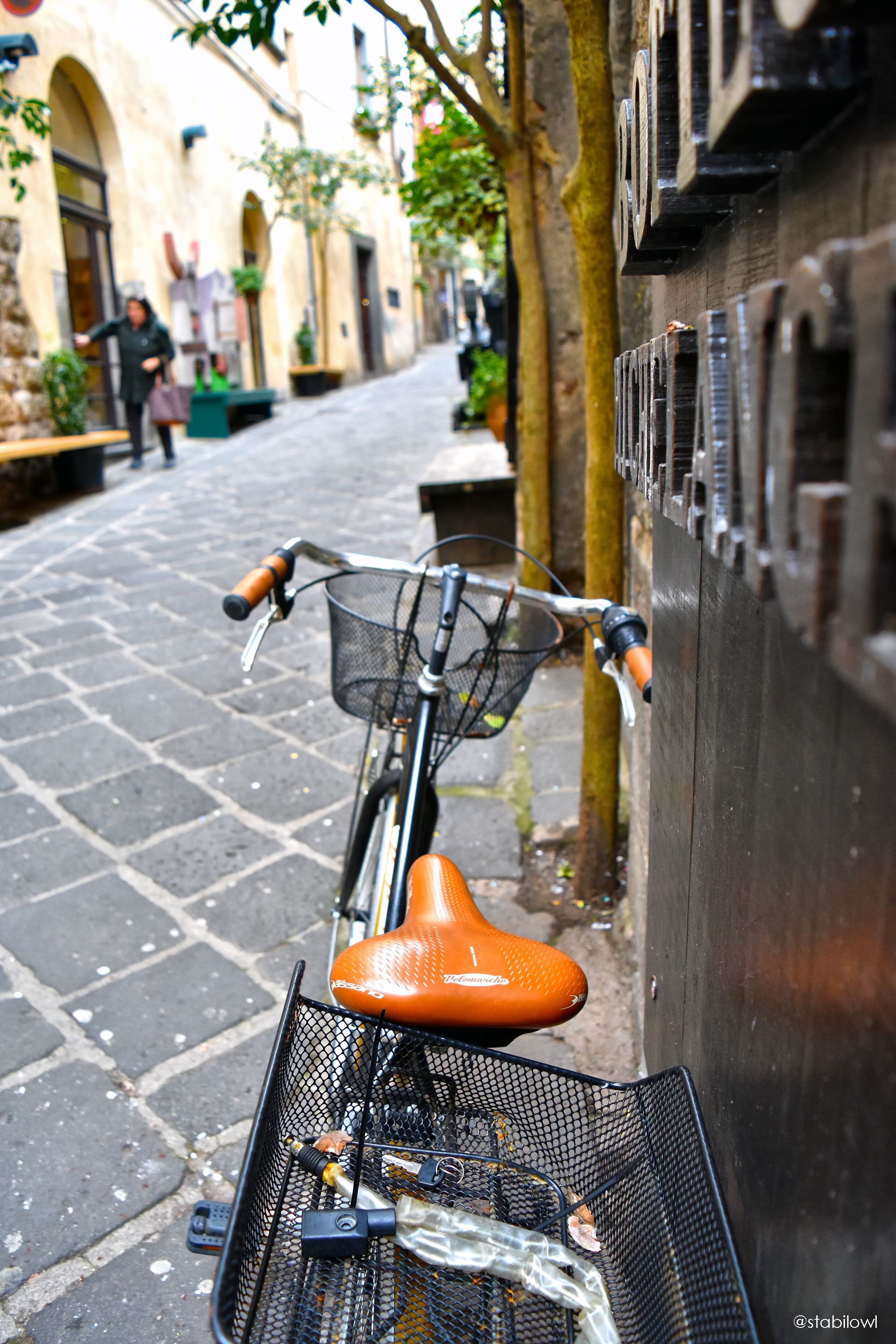


Past the centre square, we split off from the main street and walk through a labyrinth of laneways, until finally, we reached our B&B. Except it didn’t look like a B&B as there were no signs or door bell, and there was a big gate blocking the complex. We didn’t expect that, and my SIM card wasn’t working. Just when we started to panic, a gentleman opened the gate and asked what was going on. We gave him the phone number of the owner and he called him for us. A few minutes later the owner showed up, apologizing for being late. It turned out that he worked at a nearby hospital and he was expecting us to call him when we arrive, without realising that we are actually from overseas and don’t have a workable phone. So this B&B Sant’Andrea is actually more of a homestay. The owner lives there and he rent out the two other ensuites in his apartment. He gave us the room with the ceiling decorations that he claimed dated back to the 1700s. From the window we could see clearly the buildings next to us, which all looked very weathered and full of history. So that ceiling decoration was probably really dated back to the 1700s. After a brief and a quick lunch at a local café where I had the most amazing tuna pasta salad, we went and explore the town.
穿过城中心的广场,我们离开了主街,在纵横交错的小巷兜兜转转,终于到达了我们的民宿。然而这民宿跟我们想像的不一样,没有招牌没有门铃,只有一扇紧闭的铁闸。我想把电话拿出来给民宿老板打电话,才记得没有买电话卡,没办法打,也不能上网。就在我们快要崩溃的一刻,一个意大利帅哥开门了,问了我们的情况。他帮我们给民宿老板打了电话。过了不久,一个中年男子匆匆的赶了过来,一边跟我们道歉一边带我们上楼。原来这个民宿老板在附近医院工作,想着我们快到达时会跟他打电话,却没想到我们没有电话卡。而这个叫B&B Sant’Andrea的民宿原来是他的家,他把两个带浴室的房间租给游客来赚点少钱。他给了我们一个天花板的木梁上有图案的房间。他说这些图案源自十八世纪,非常罕有。虽然不知道他是不是在吹牛,可是从窗户外看到对面平房古老的房顶和历尽风雨的墙壁,说这栋房子有几百年历史真的不足为其。整顿一下后我们在附近的小餐馆吃了个美味的午餐(他们的金枪鱼意大利短管面真是一绝!),然后就准备继续我们的古城探索。
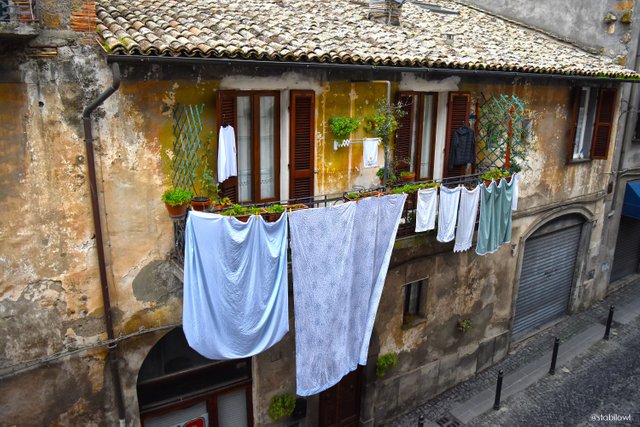
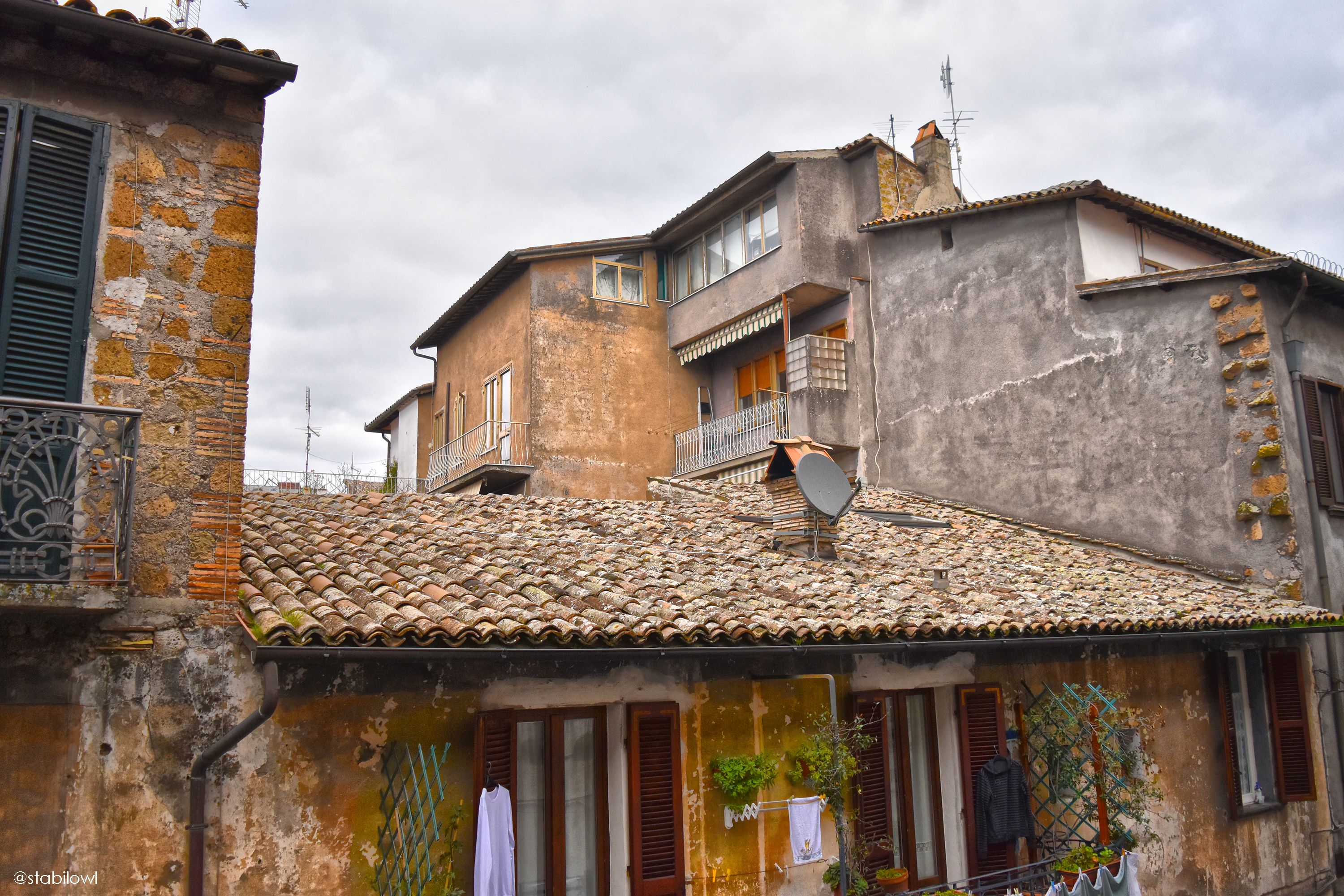
.jpg)
I wanted to see the town from outside so that I can take some shots of the town sitting on top of the giant rock. We went down hill from the town centre towards the south gate. On the way we saw more steep laneways and historic houses, and spent ample time posing in front of stone staircases and weathered brick walls. Eventually, we made our way past the gate, and continue going downhill outside of town. As soon as we stepped out of the town we saw grass fields and vineyards, something that is typical in the Italian countryside. As we walked downhill I kept looking back, trying to see if I could get a good glimpse of the town perching on top of the rock. It was not until we walked completely down hill and crossed the road to a nearby field before we saw what we were looking for: Part of the town can be seen on top of an elevated rock platform, with the cliffs that are almost vertical. As we walk further out, we reached a small village where we could see more of the Orvieto township. The village itself was all you would expect for a modern Italian village, with old buildings, narrow roads, lots of off-street parked Fiats and cats walking on roofs. We followed the road going uphill again, eventually came to a spot where we could clearly see the whole of Orvieto perching on top of a hill in a distance. We could even see the reflections from the gold facades of the Orvieto Cathedral. It is really quite a sight to behold.
我想看一下奥尔维耶托在岩石上的全景,所以我们从城中心下山往南边的城门走。沿途是更多的充满古镇风韵的斜巷和楼房。在石板台阶上,古老石墙边,我们一张一张的摆拍。就这样走走停停的,最后到达了城墙的南门。城墙外,翁布利亚郊野的风景尽入眼睑,微黄的草园和光秃的葡萄园构成了这冬日意大利近郊的画面。我一边往下走一边往回看,想看到那种高山古城的感觉。可是需要一直走到山脚,才开始看见奥尔维托尔的面貌。奥尔维托尔古城在岩石上显得多么高高在上,岩石旁险峭的悬崖更是让古城变得庄重威严。过了马路我们到达了一个现代化的小村庄。那古旧的砖房,路边的菲亚特小车和屋顶上的猫,让这小村充满了意大利的气息。越往前走,我们看到古城的部分越来越多。最后,在小村边沿的山坡上,我们终于看到了这座雄伟古城的全貌。在下午的阳光下我们可以远远看见大教堂外墙的金壁闪闪生辉,真是非常漂亮的景观。

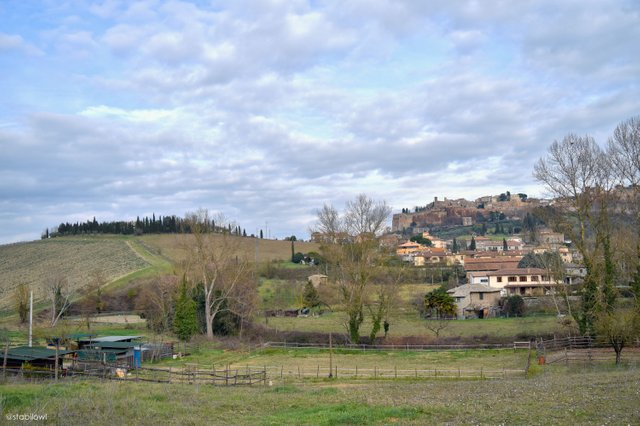
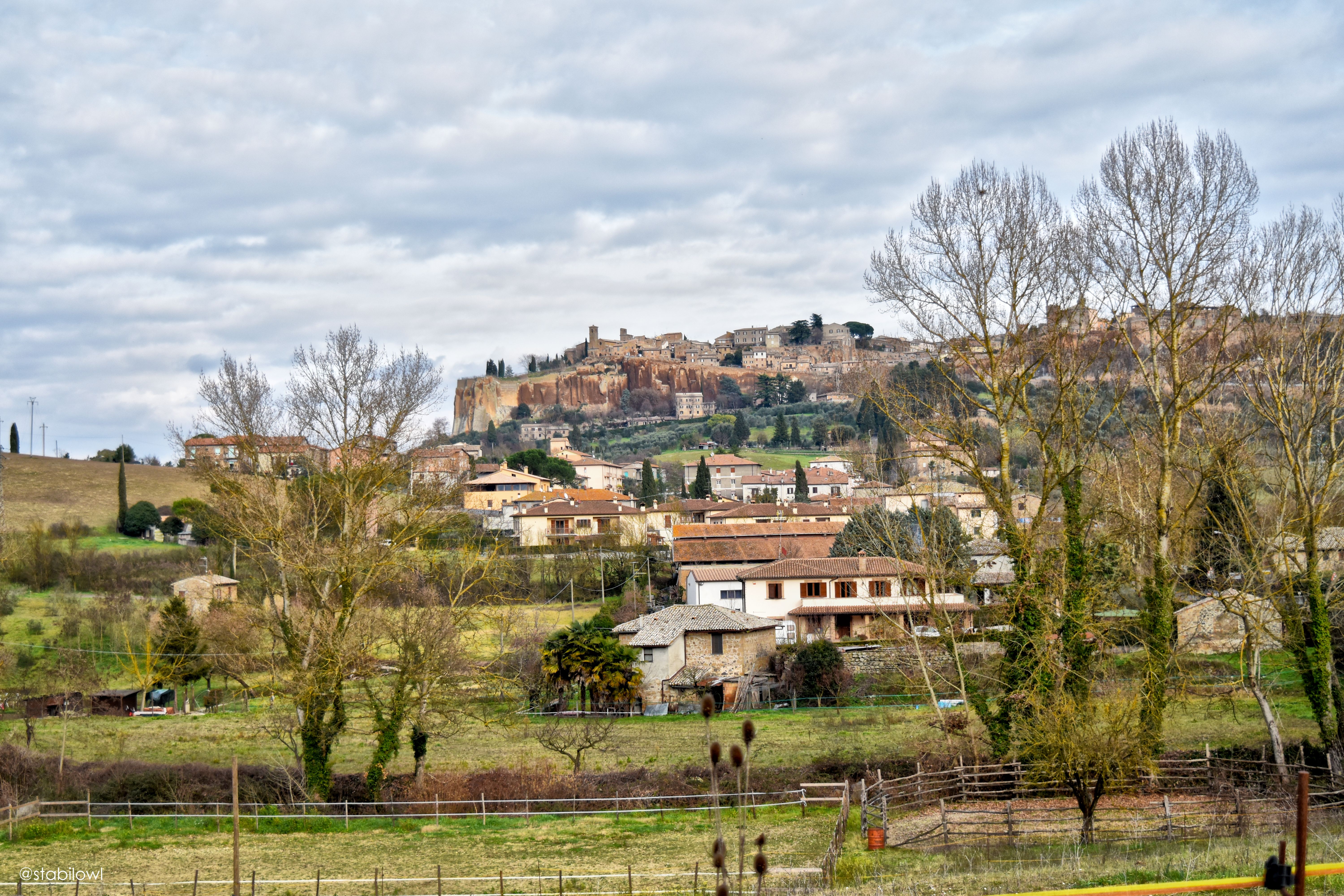
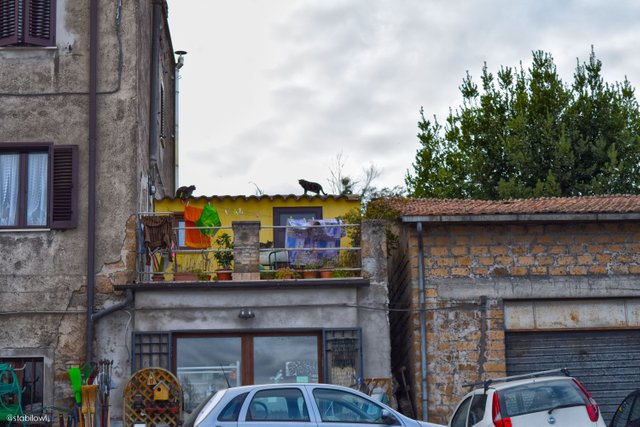
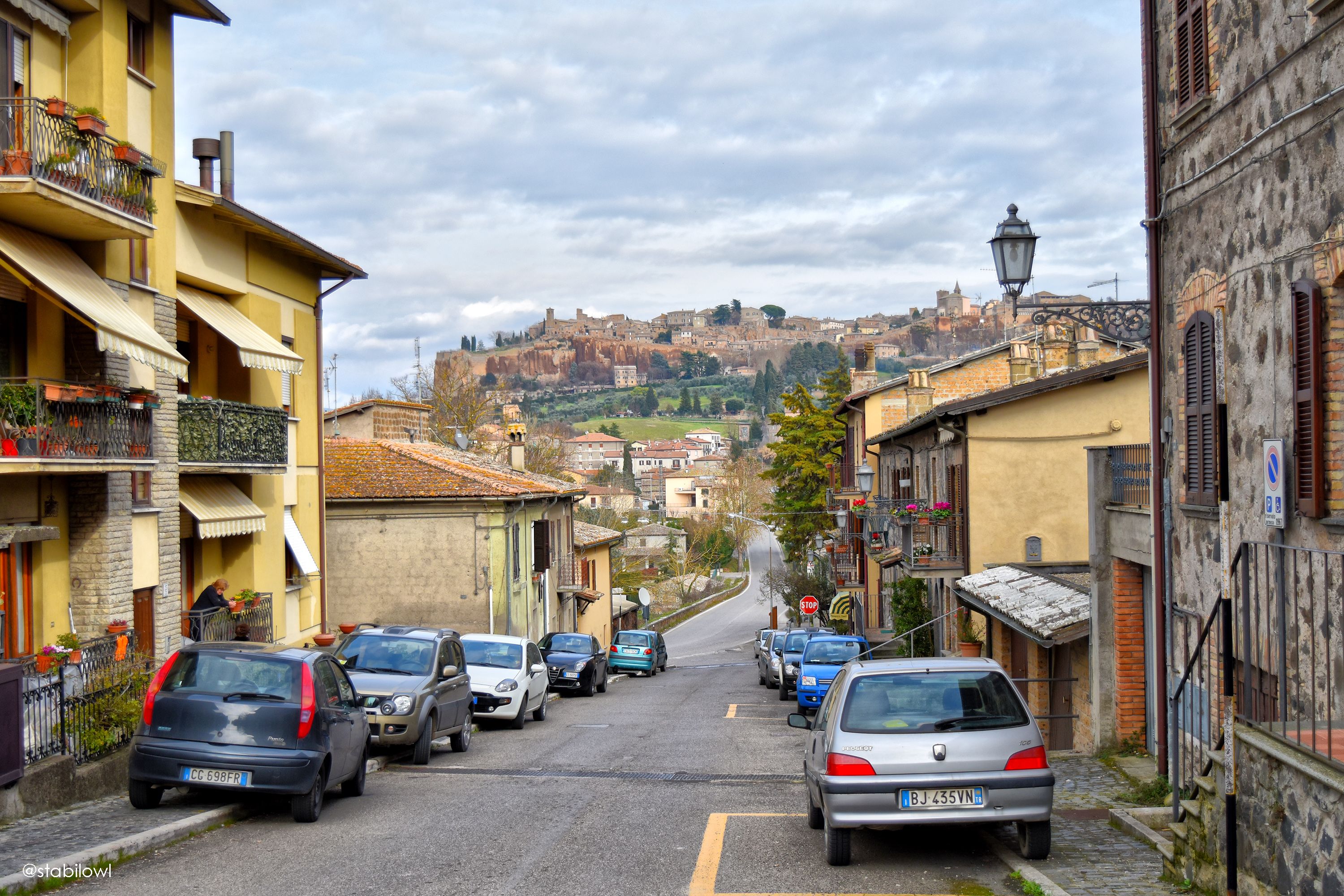


Back in Orvieto, we decided to visit the Orvieto Cathedral up close and personal. The Orvieto Cathedral, or Orvieto Duomo, has quite a history. It was ordered to be built in 1263, when Pope Urban IV was residing in Orvieto, but the construction did not start until 1293 by Pope Nicholas IV, and the whole construction spanned 3 centuries, with the cathedral completed in 1591. Because of this long construction time, the cathedral has both the element of Romanesque architecture that was popular in the 13th century, and element of Gothic Architecture that was popular in the 14th century. This can be clearly seen in the Cathedral exterior, where at the bottom Cathedral concentric arcs, a typical design in Romanesque architecture, was used for the main gates. However, further up the exterior, golden triangular facades and sharp spires were used, which are typical features of a Gothic design. There are also various statues and cravings of bible characters appeared at different places on the front Cathedral wall.
回到镇上,我们与奥尔维耶托大教堂来了一次亲密的接触。奥尔维耶托大教堂历史非常悠久。公元1263年,当时在奥尔维耶托居住的教宗乌尔巴诺四世下令兴建大教堂,然而教堂在1293年在教宗尼古拉斯四世令下才开始动工,用了三个世纪在1591年才建成。长达三百年的工程让大教堂混合了罗马式建筑和哥特式建筑的元素。从教堂的外墙就可以看见底层的大门用了罗马式的圆拱设计,而顶部则采用的哥特式的金色三角外墙和高高的尖顶。教堂的前墙还采用了很多不同圣经人物雕像作为装饰。
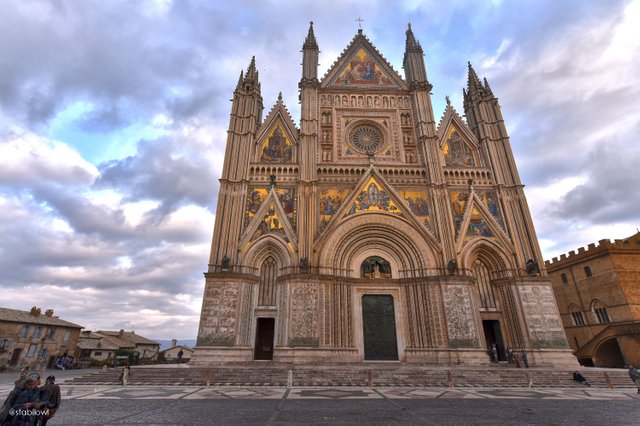
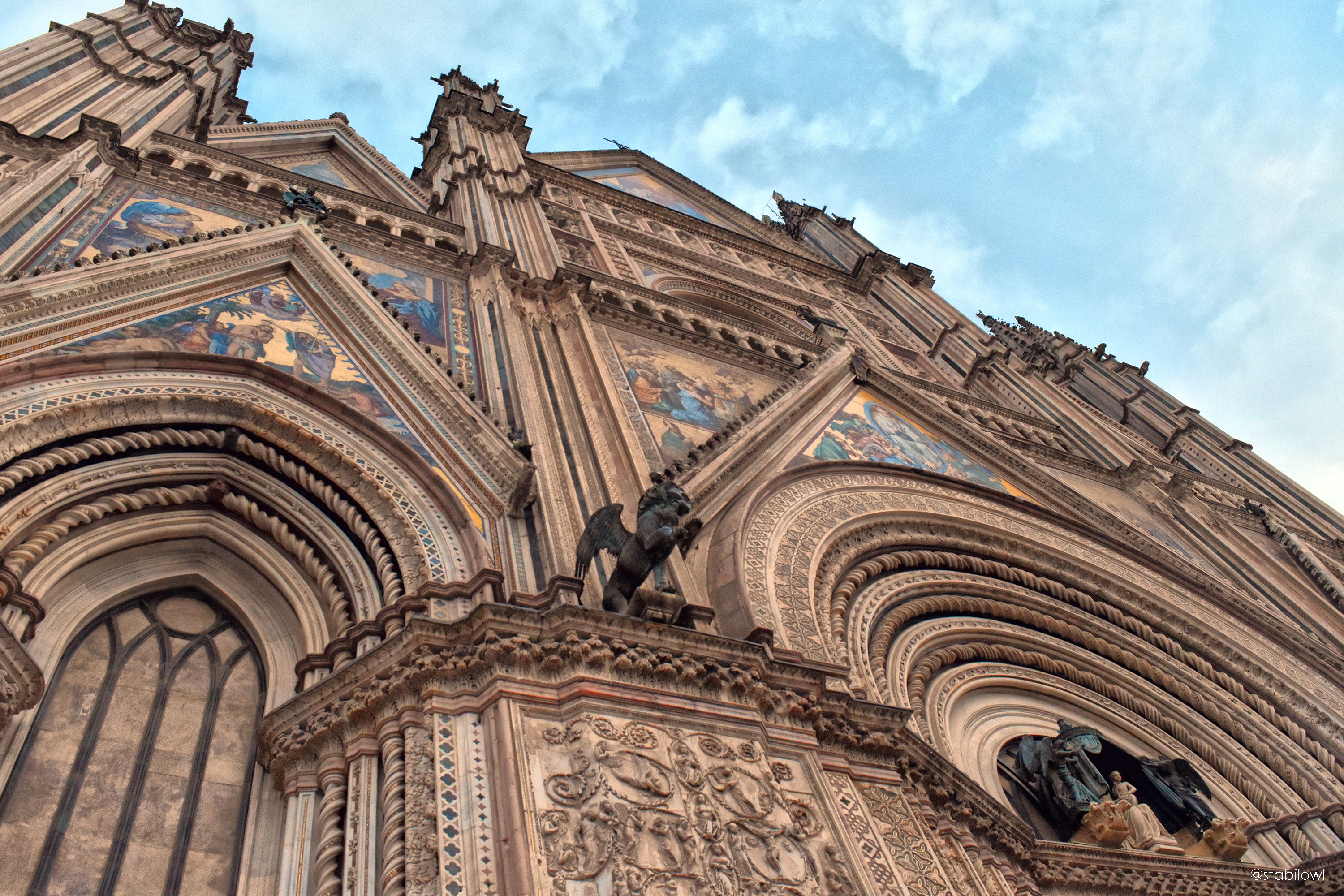
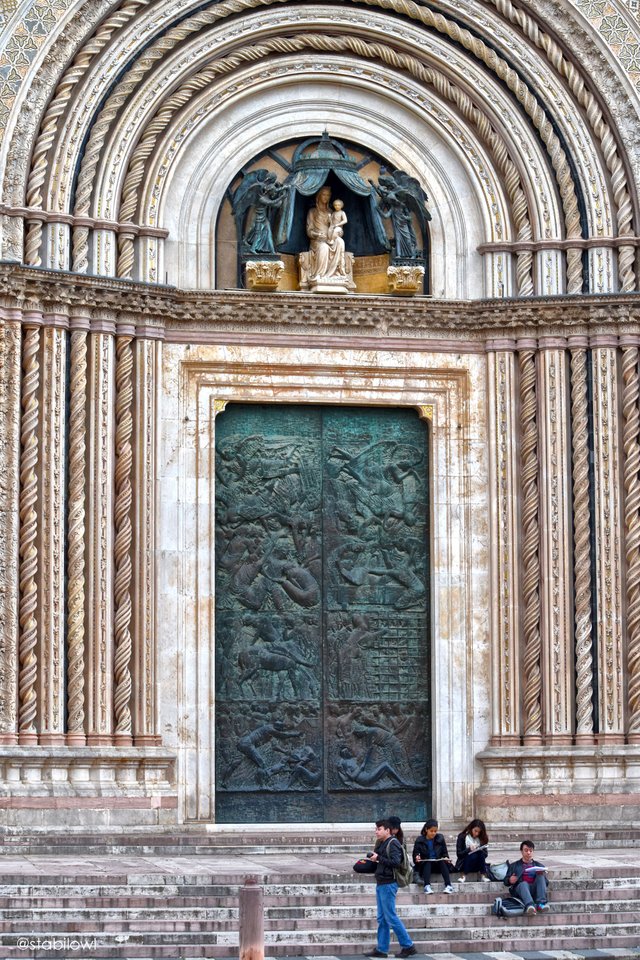
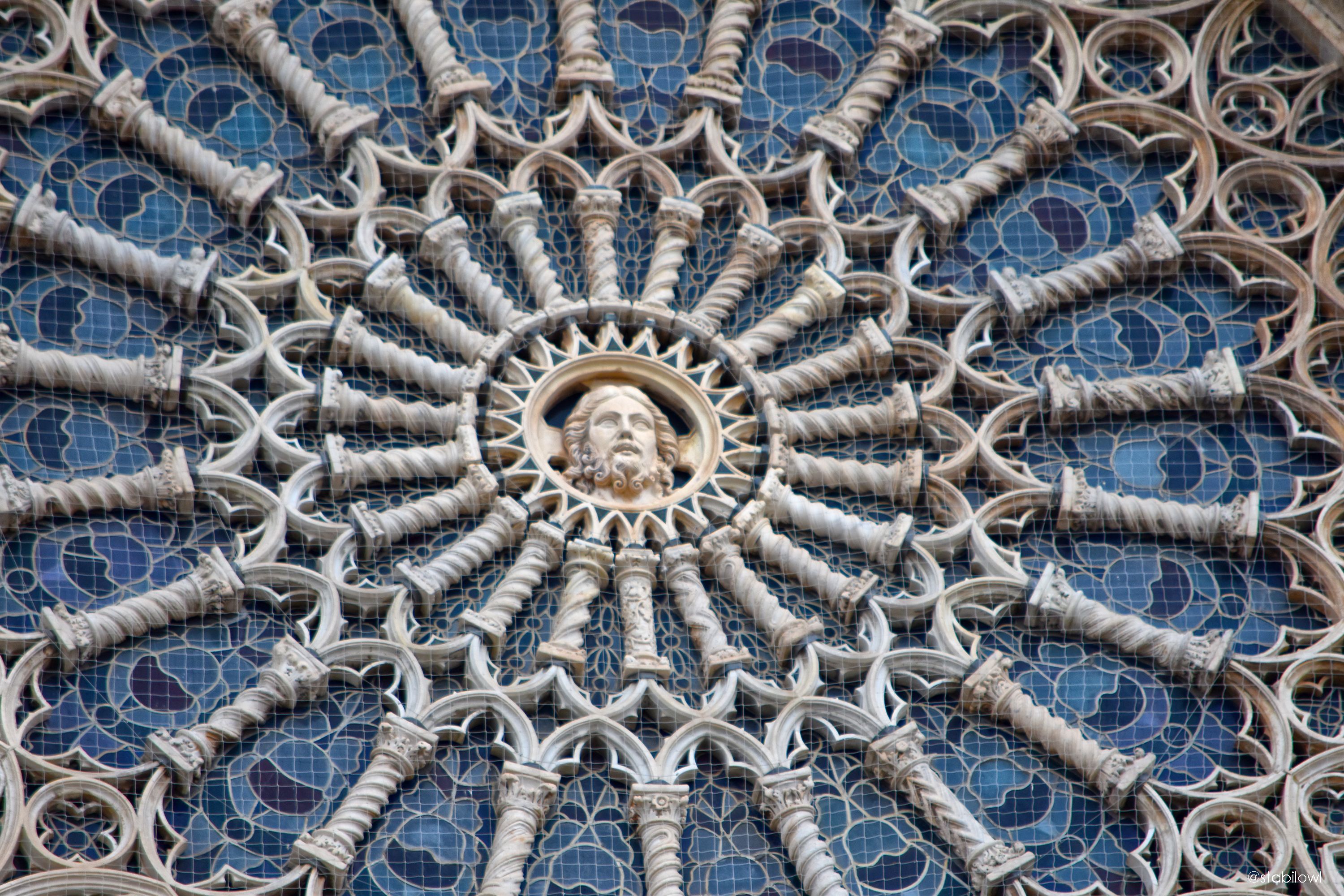
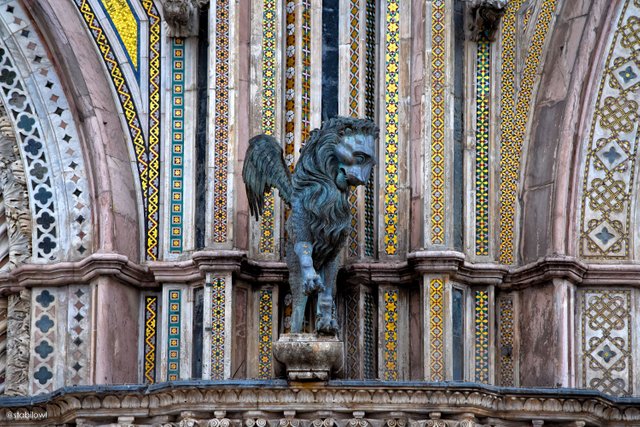
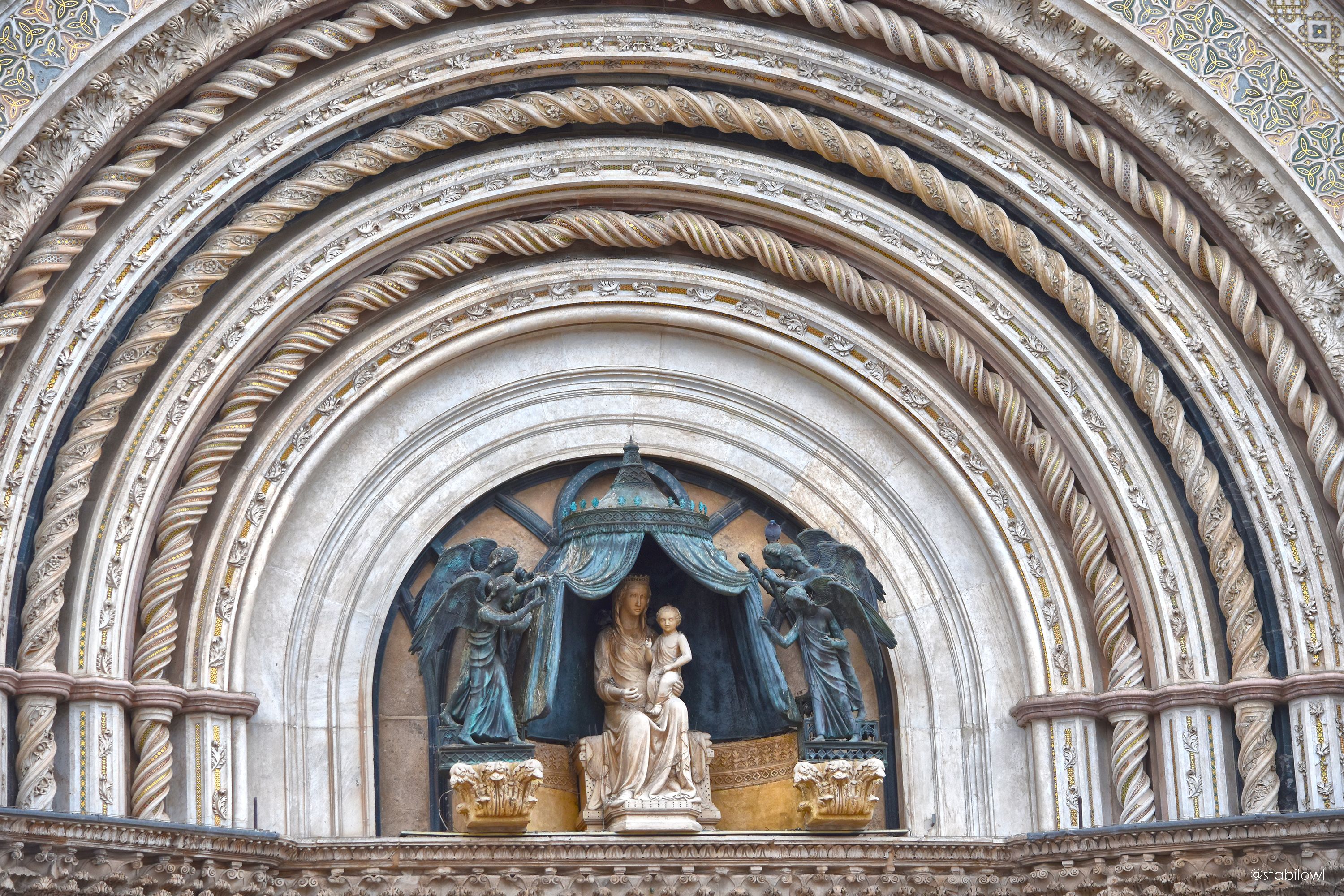
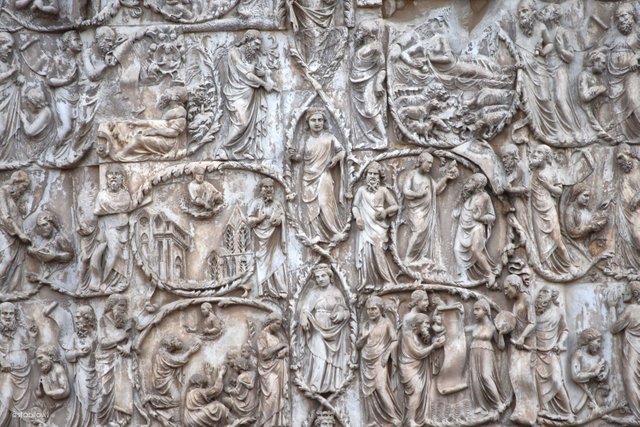
The interior of the Cathedral is quite spacious, again displaying the change from the Roman arches and stone columns at the bottom to the triangular frescos and sharp roofs up on the top. A lot of gold has been used in the construction of the Orvieto Cathedral, as can be seen from the many golden frescos and altars in the various chapels rooms. The black and white stripes on the walls are actually alternative rows of basalt and travertine, two different type of rocks that gives alternating colours. Many colourful tainted glass windows can be found within the Cathedral – another feature that makes Orvieto Cathedral such a gem. Interestingly, Orvieto has always had strong links with the catholic church and the Holy See, and has seen many popes residing in the city over the years. During the sack of Rome the then Pope Clement VII chose to take refuge in Orvieto as geologically It is much easier to defend. He even ordered the digging of a deep well to access ground water underneath the rock in case the city became under siege.
教堂内部非常宽敞,也同样地可以看见内部设计从底部的罗马式圆柱到哥特式的天花壁画和尖顶。奥尔维耶托大教堂的设计中用了很多黄金去打造金壁辉煌的金黄壁画和祭坛。而众多的彩色磨砂玻璃窗也是奥尔维耶托大教堂的特式之一。其实奥尔维耶托从很早期的中世纪就因为它的地理位置而备受罗马教庭的青睐,历代以来很多教宗都在这里居住过。其中在罗马之劫时,教宗克雷芒七世就逃到这里避难,还在这里建了口深井,为被围城做好准备。
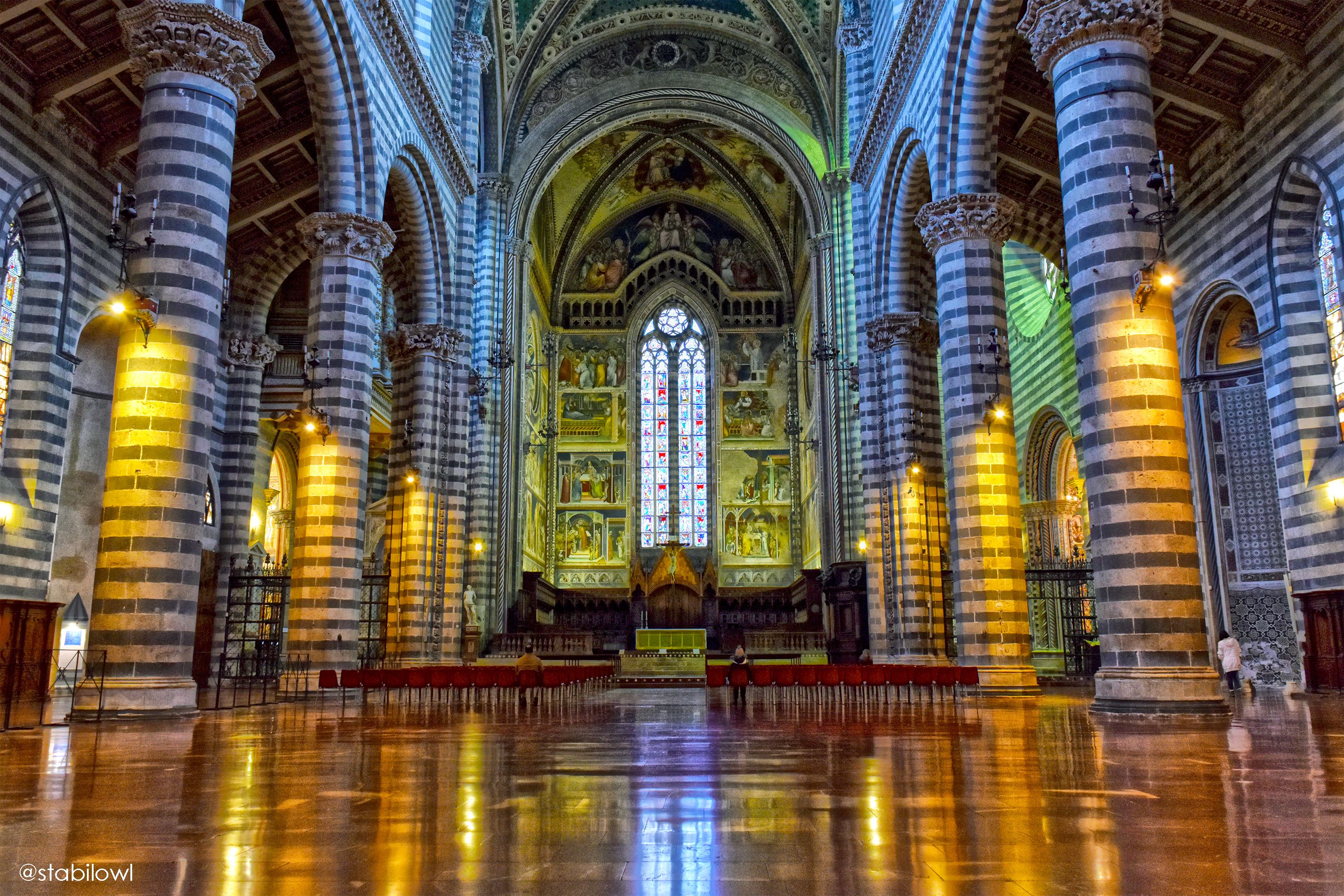
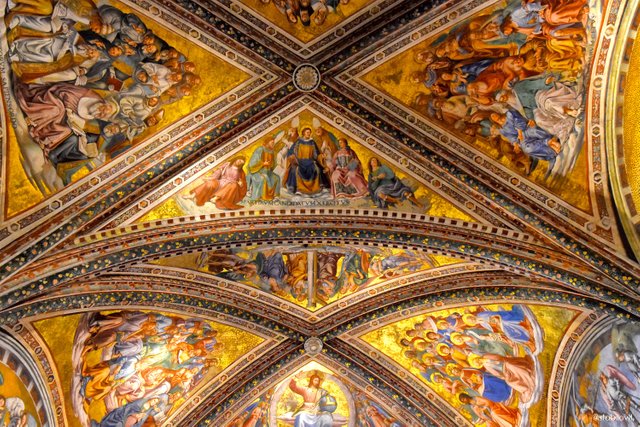
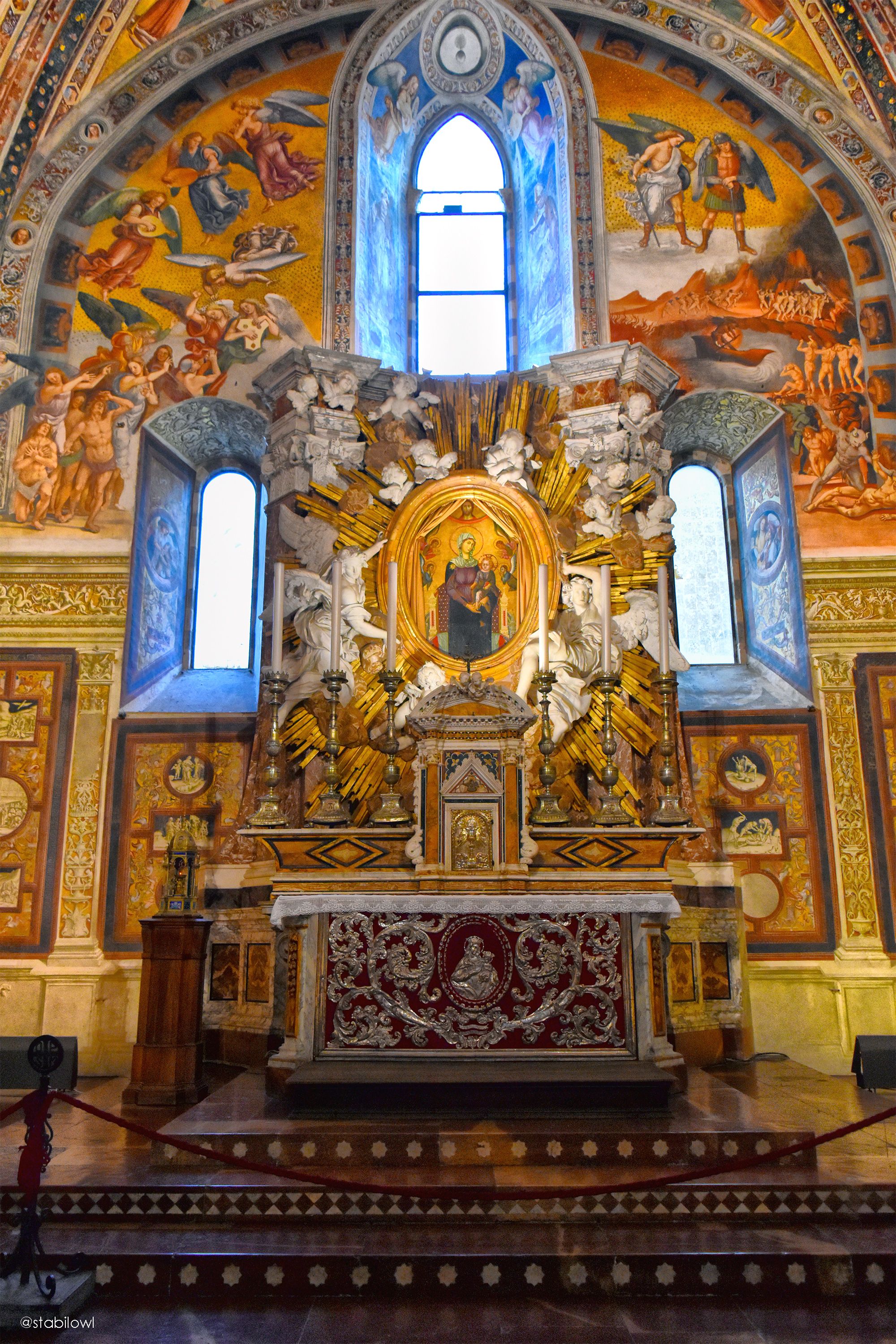

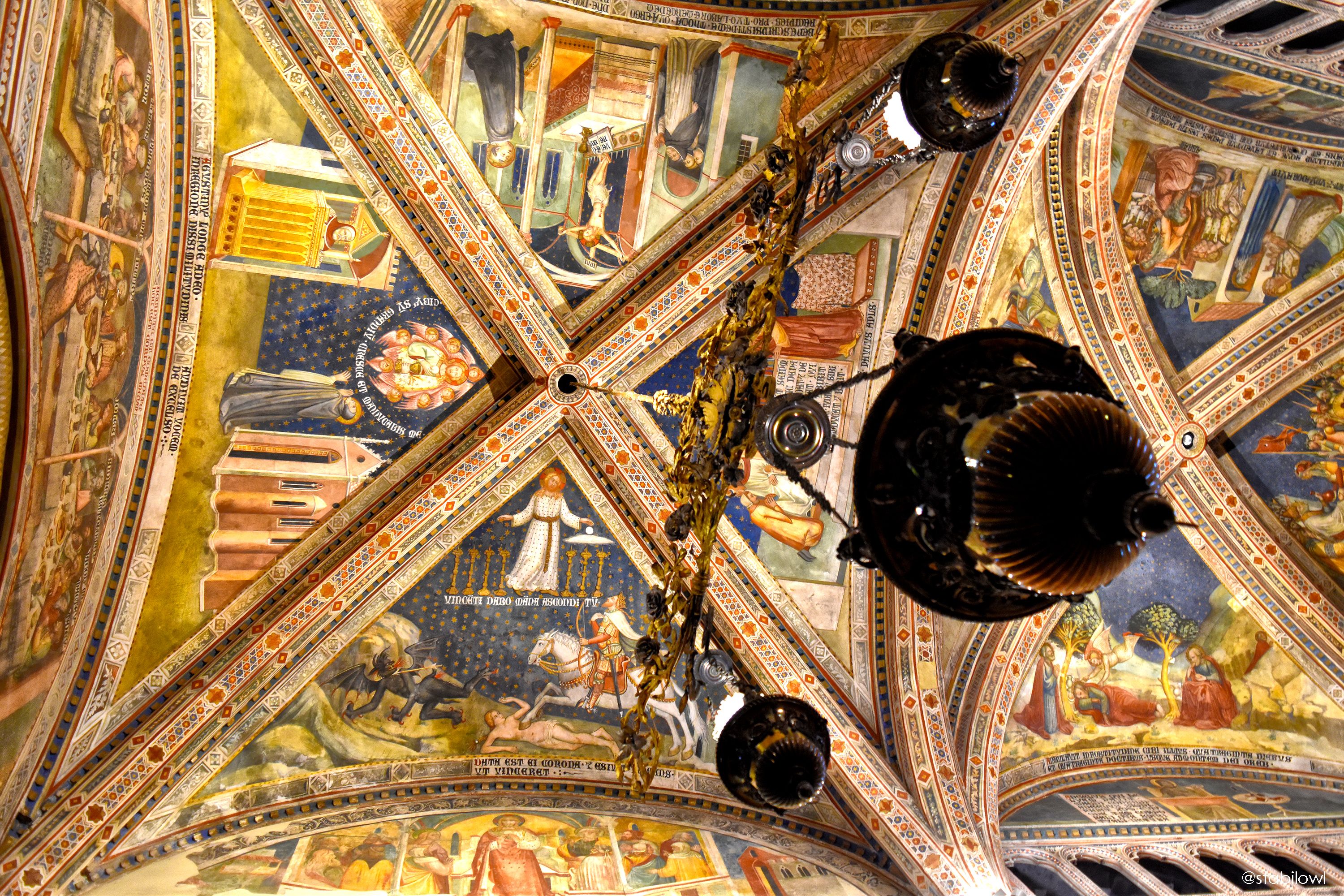
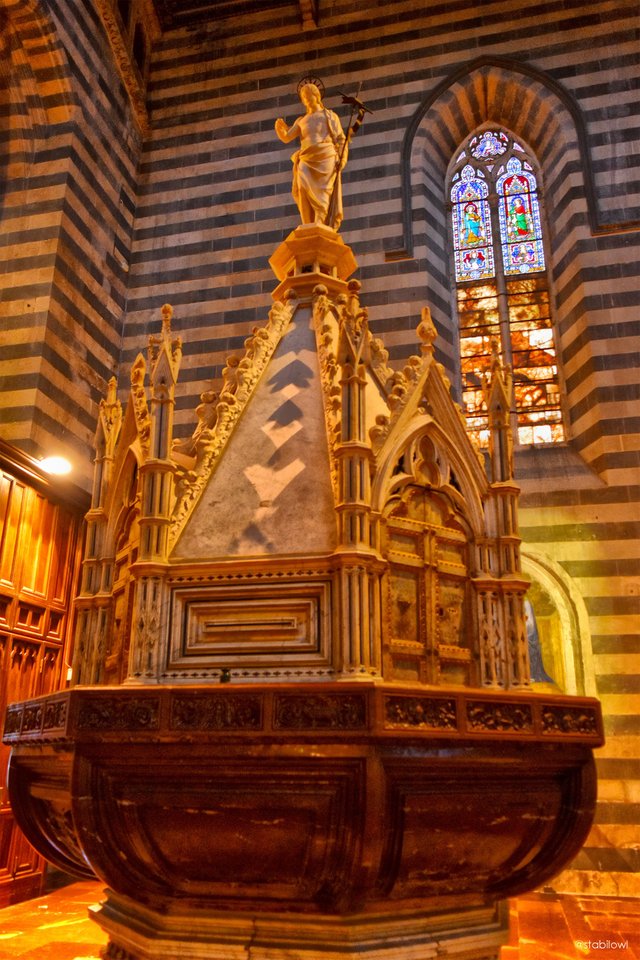
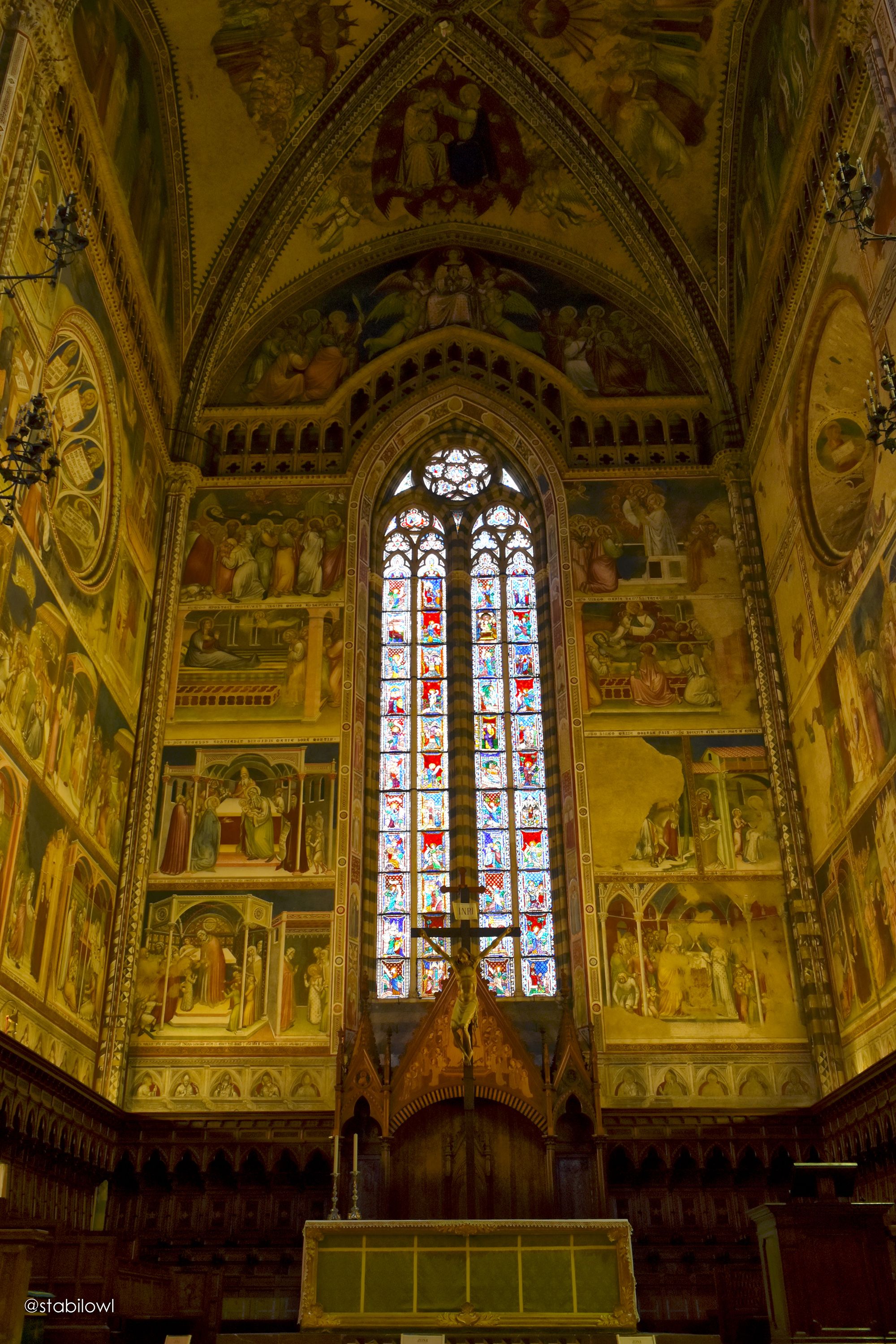
As the sun sets, lights came on around the town square but Orvieto is really for bed. There are little shops that opens till around 8 pm, and little lanes that were decorated with colourful lights. The Catheral’s golden façade looked spectacular under illumination by the street lamps, and restaurants serves the regional specialty – wild boar meat in various forms – until late. However, night life in Orvieto was confined to a few drinks at the local wine bars and locals chit-chatting on the stone steps by the town hall. As one would expect for a quite town. We went straight back to our accommodation after dinner and quickly fell asleep.
从教堂出来,太阳已经下山了,夜幕降临奥尔维耶托。虽然很多小巷亮起了五颜六色的彩灯,大教堂在众多街灯底下也变得漂亮辉煌,可是奥尔维耶托这个小镇已经准备入睡了。街上为数不多的游人,有些还在还没关门的小店,有些在餐厅里享受翁布里亚的特产-野猪肉。广场上当地居民三五成群的坐在石阶上喝酒聊天,而累了一天的我们吃完晚饭就匆匆回去休息了。


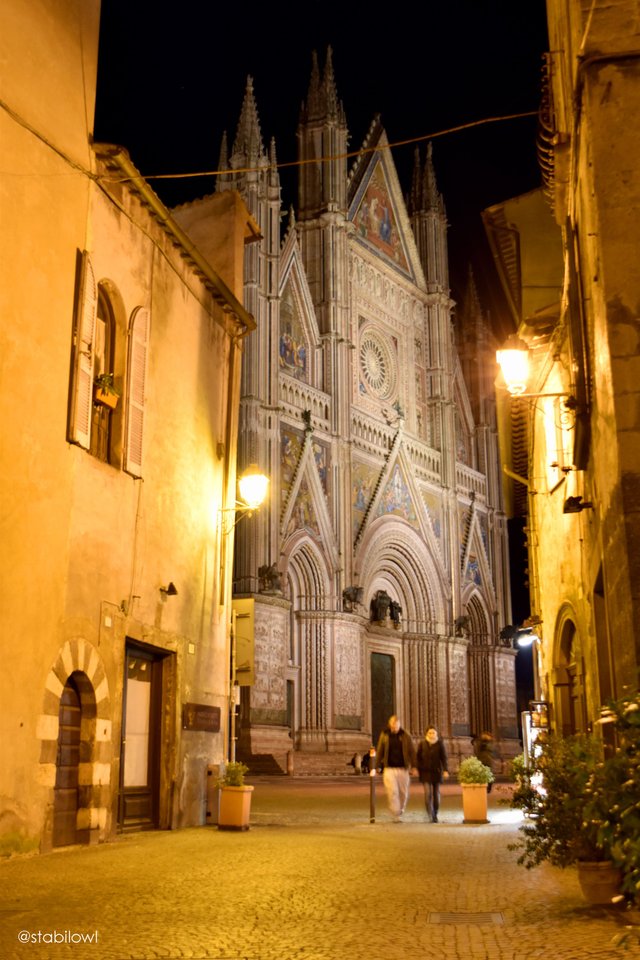
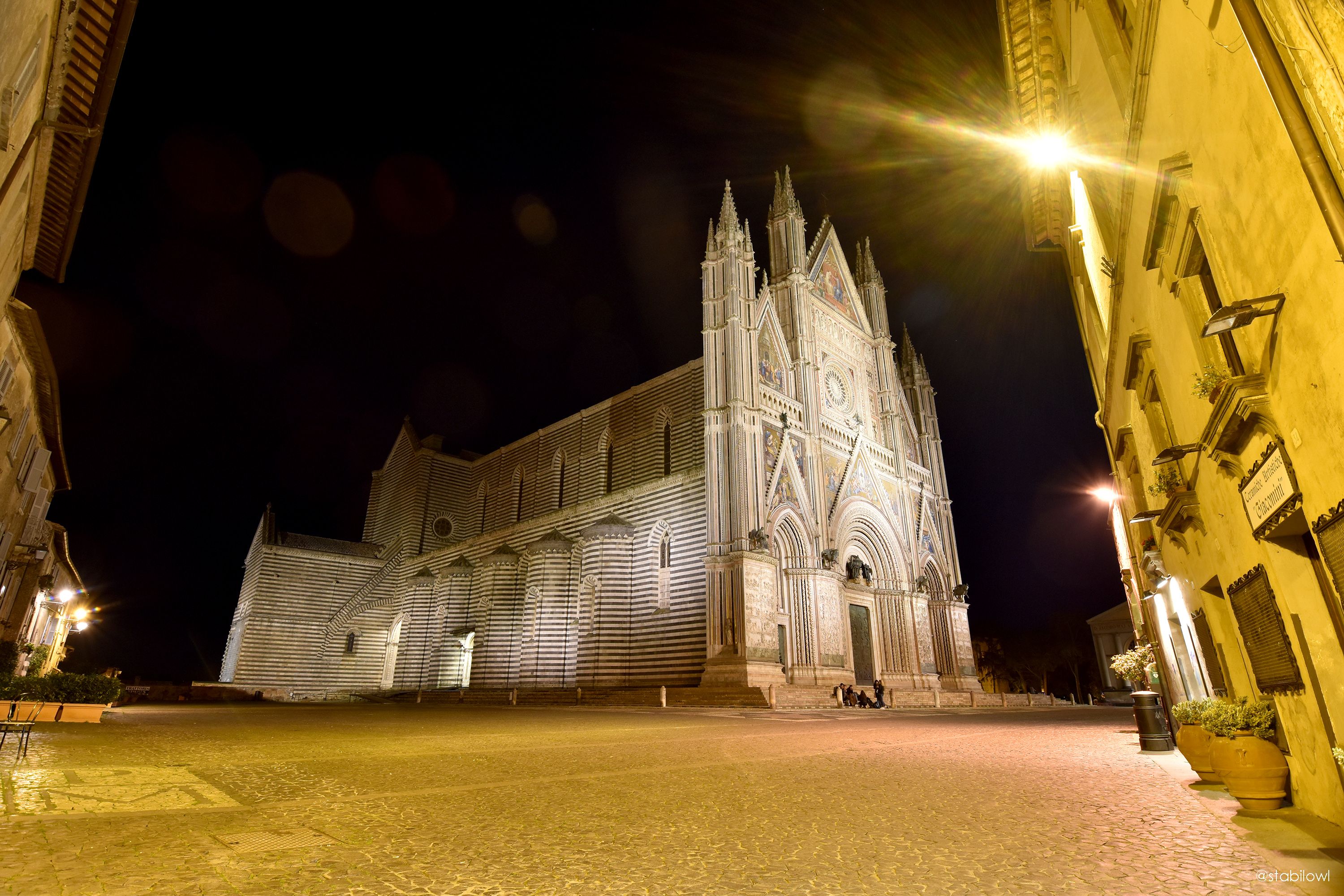
The following morning, we were going to go to Civita di Bagnoregio but we missed the bus (more on that in my next travel blog). So instead, we spent the morning exploring more of the town. As we go towards the western end of the town we saw more of the charming lanes and old buildings, waiting to be discovered. We chanced across the morning market, where they were selling various vegetables and fruits, including a funnily shaped pumpkin. Across the market was an old building where we climbed up to get a bird-eye view of the market and a glimpse of the old tiled roof tops. We went further down to the edge of the city, and found ourselves staring at the vast landscape of Umbria, with rolling hills vineyards and cypress trees, all shrouded in morning mist. We were glad that we missed the bus, as we would not have seen this amazing scenery otherwise.
第二天一早,吃完房东准备的丰盛早餐(其中的奶黄羊角色让人回味无穷啊!)我们就出发了。原本我们想赶上早上八点的公交车去附近的 ”天空之城” Civita di Bagnoregio,可是我们把车站地点搞错了。错过了这班早车,下一班车要等到下午。我们只好在城内闲逛。我们往城西方向走,沿途都是迷人的小巷和古楼,等着被游人发现。我们找到了一个露天市场,众多的摊位上卖着各式各样的蔬菜和水果,包括一个形状可爱的南瓜。穿过市场,我们走到了小城的边缘,晀望翁布利亚的田野。连绵起伏的山丘被清早的晨雾围绕着,低低的云层像薄纱一样覆盖着平原上的小庄园和小路旁的柏树。看着这像画里一样的仙景,我们都觉得有点庆幸没有赶上公交。
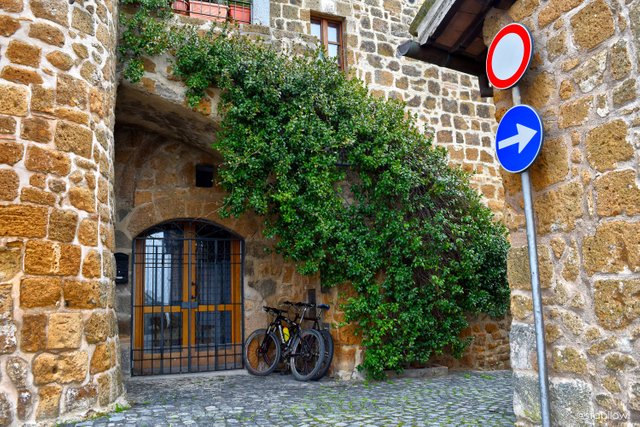
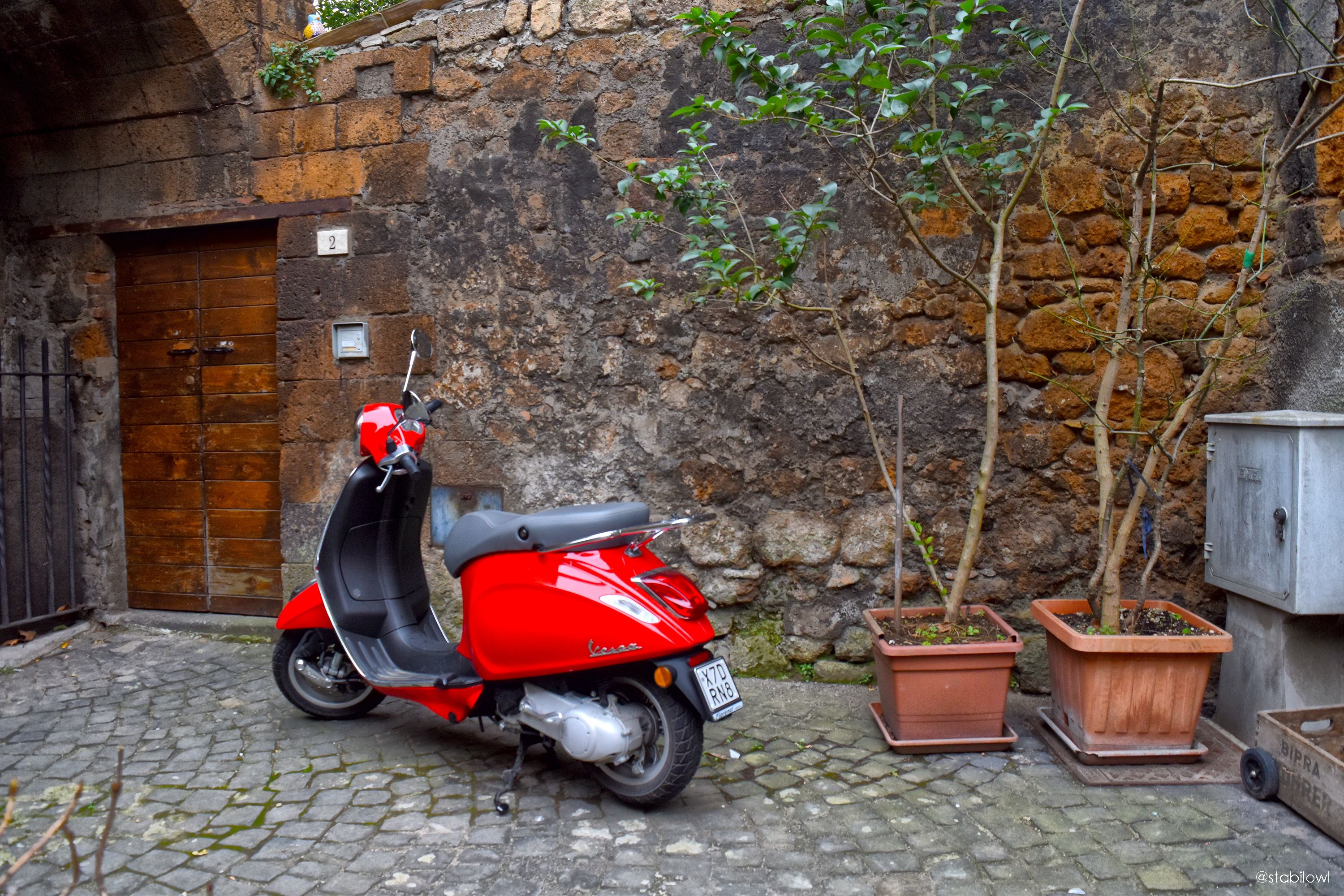
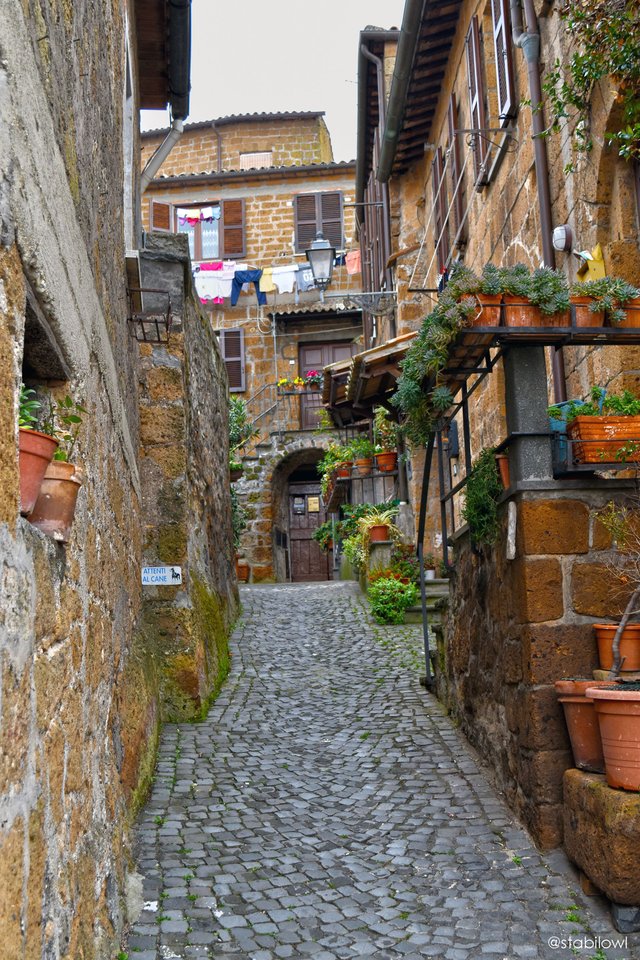
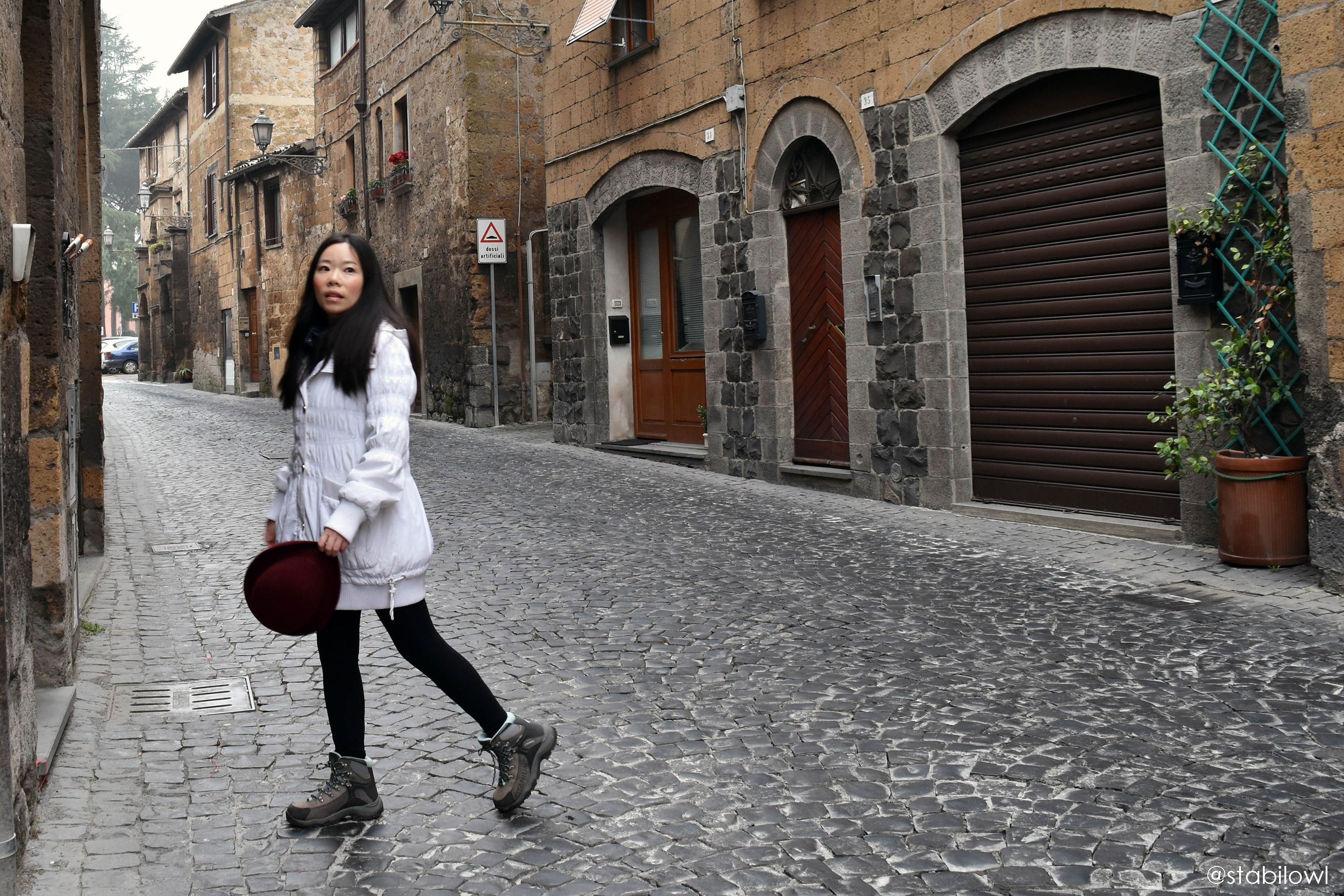
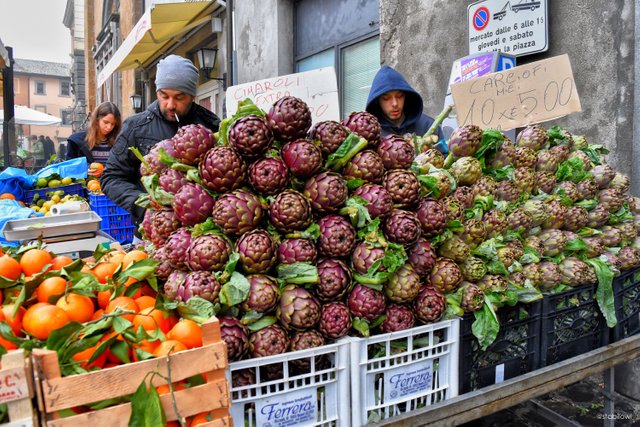
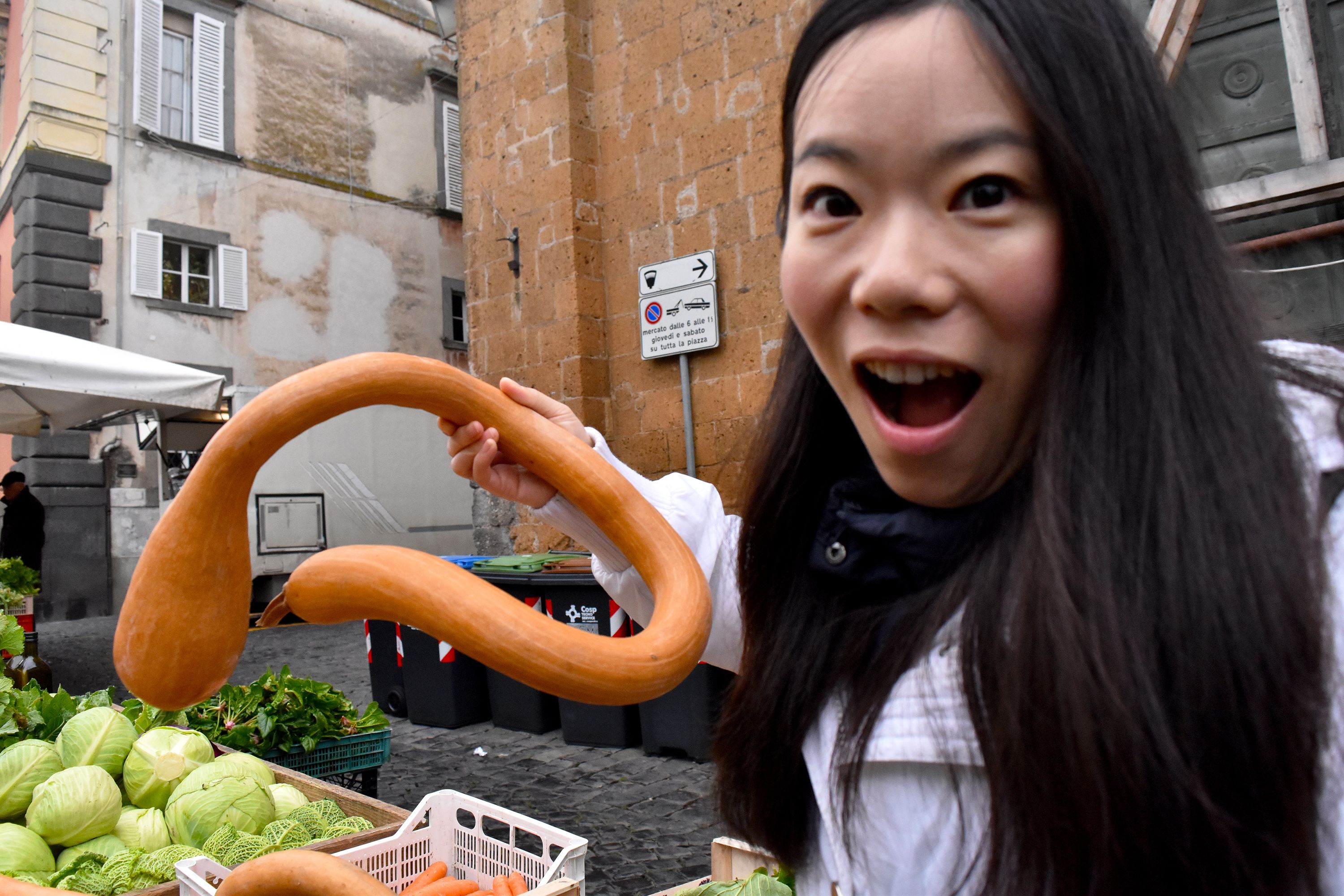
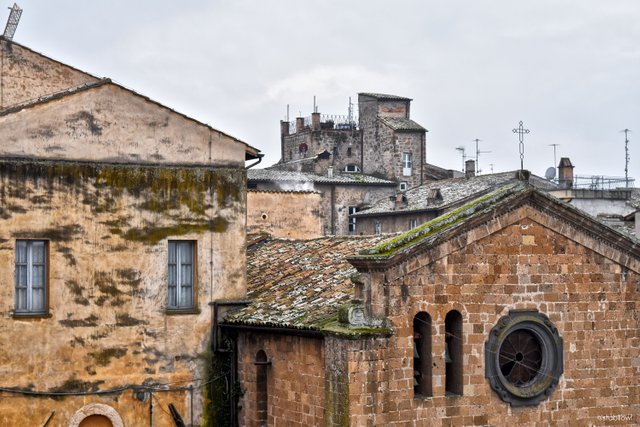
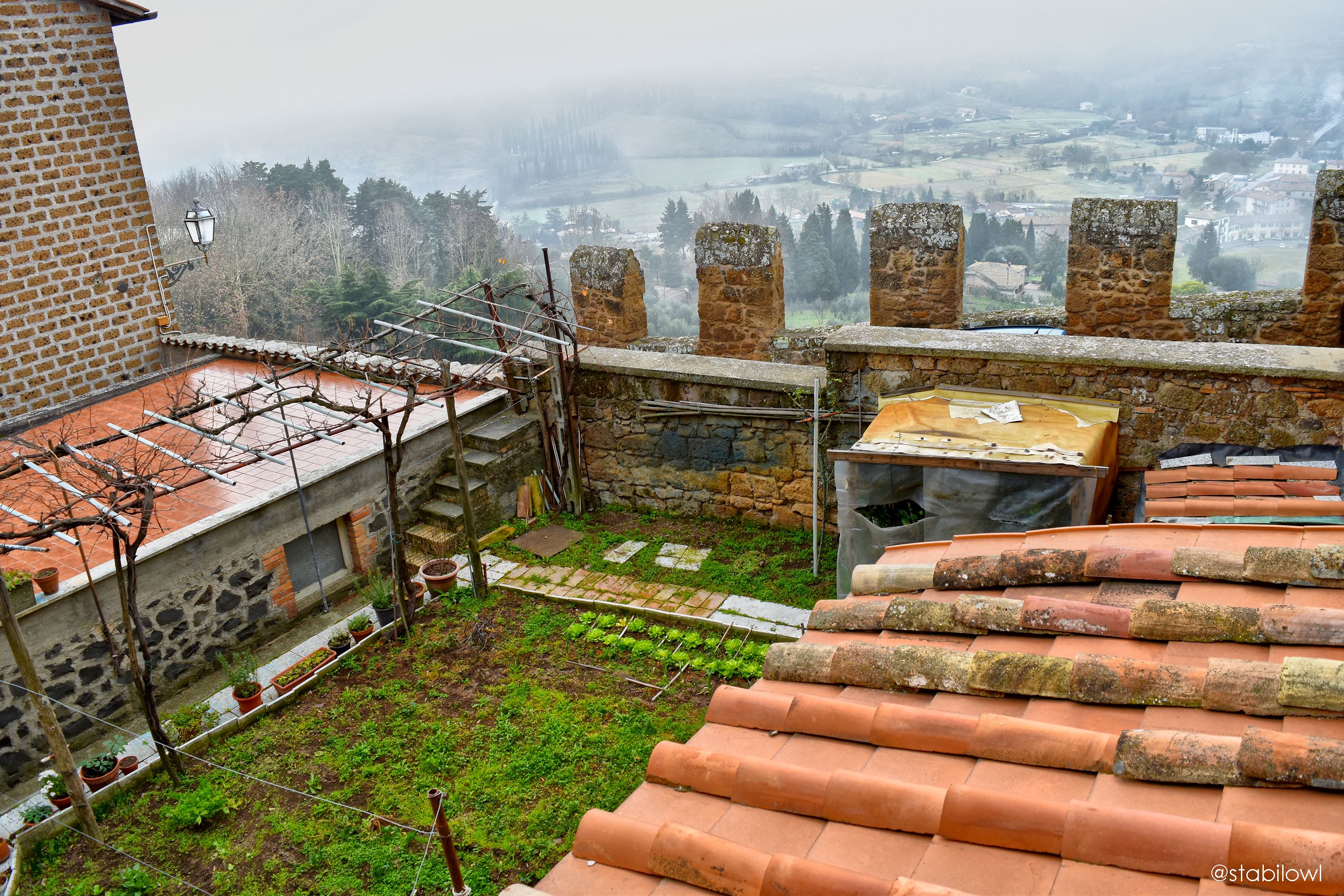
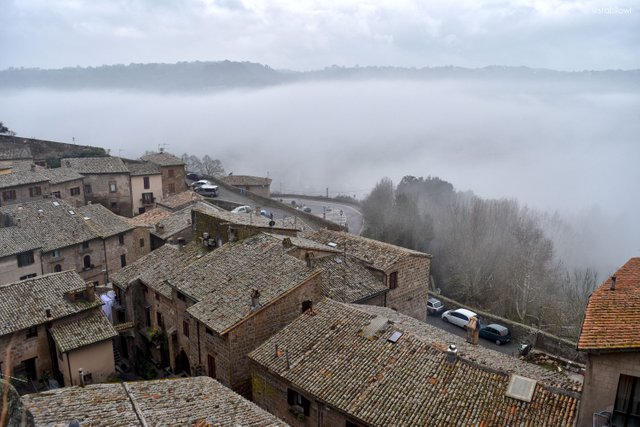
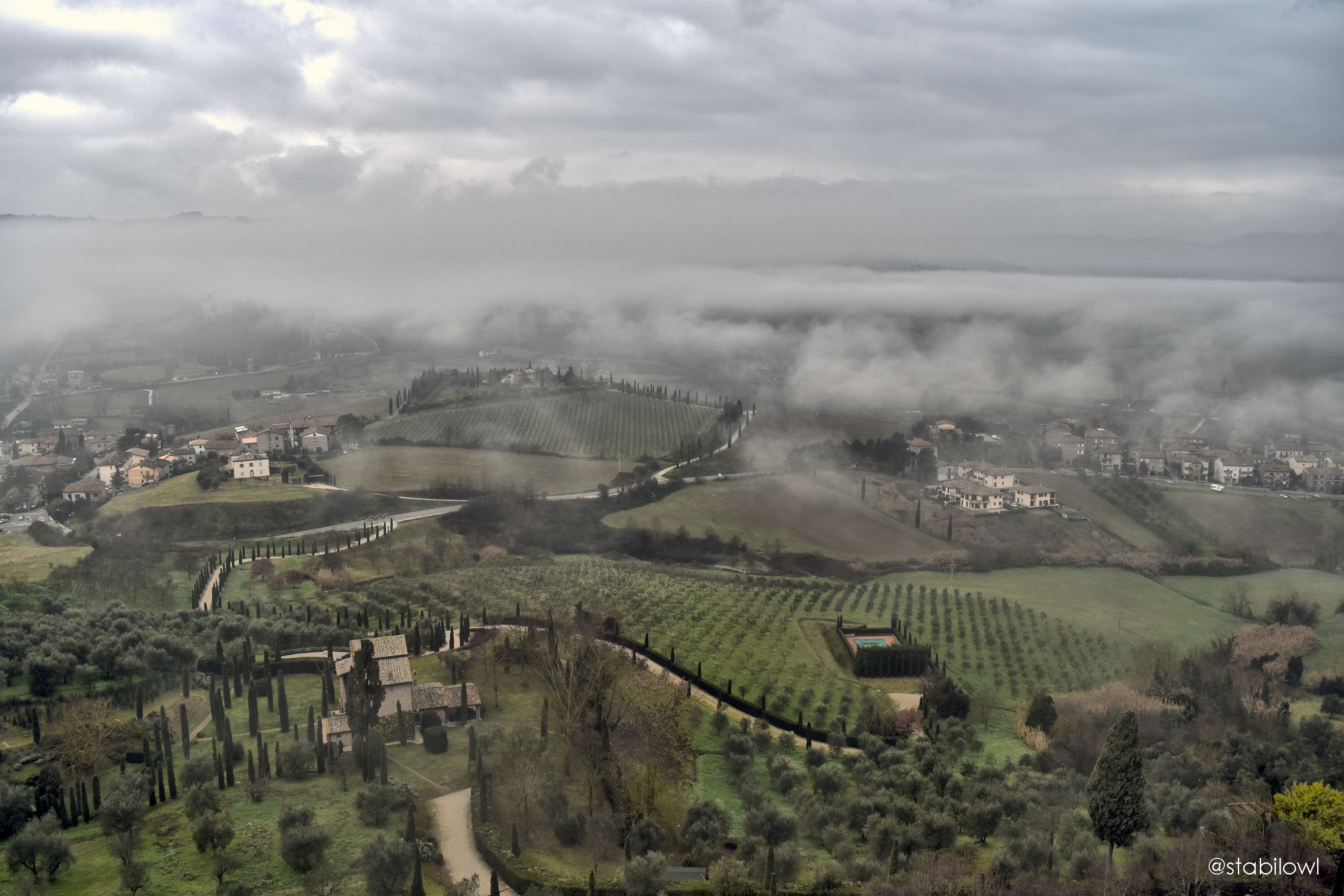
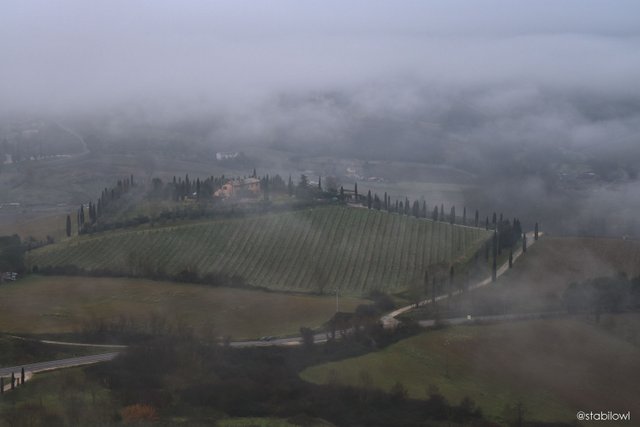
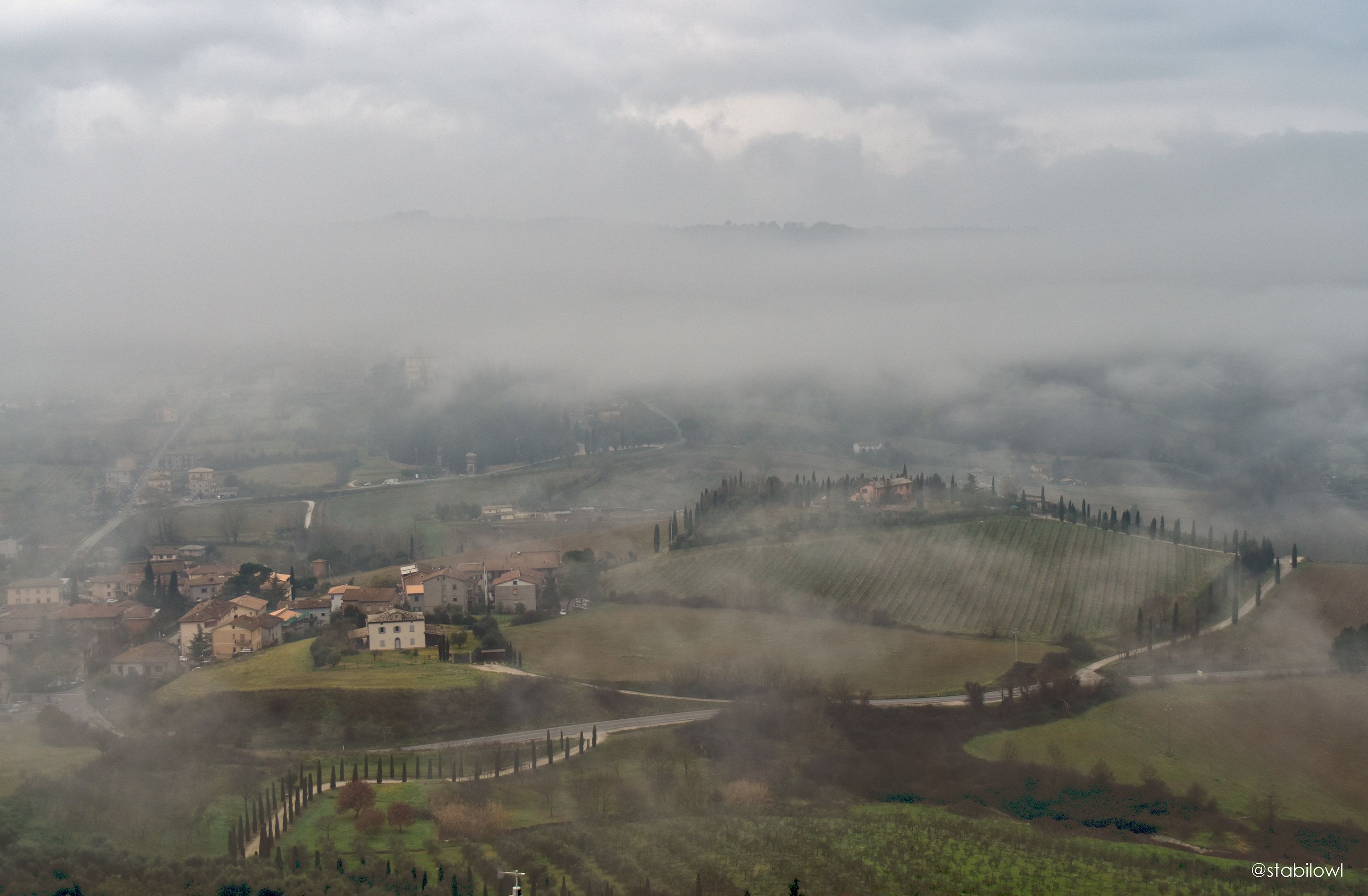
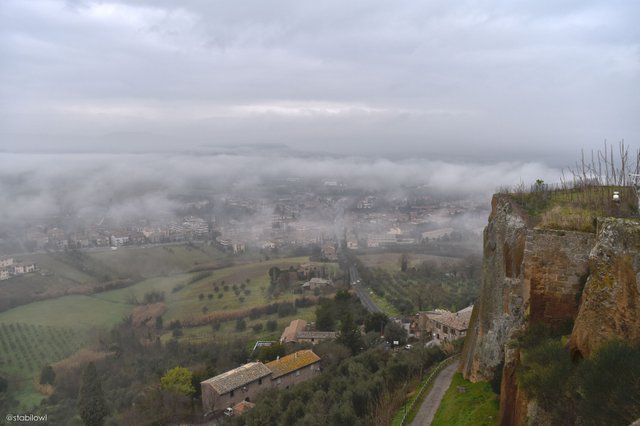
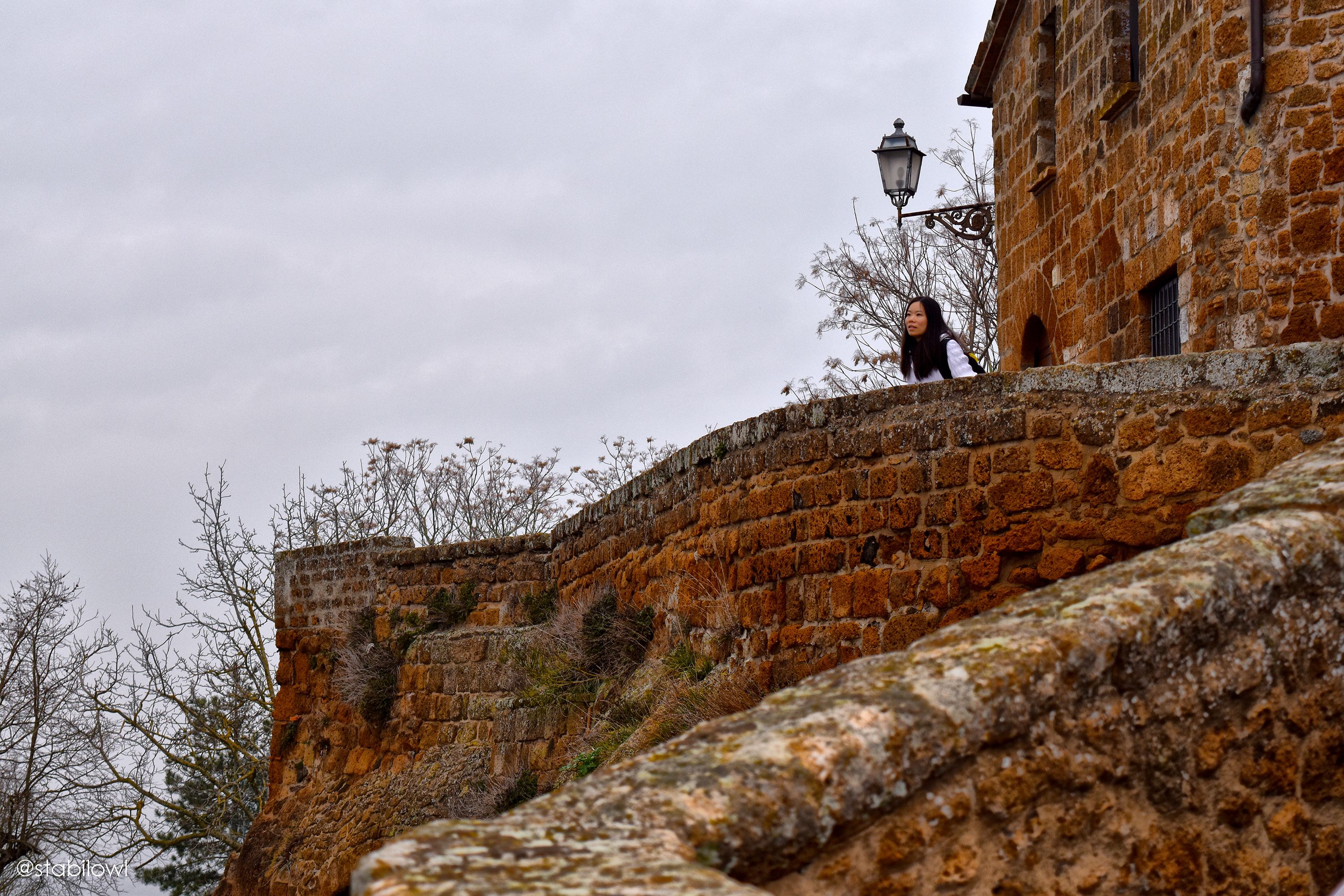
To spend the rest of the morning we decided to join the morning underground tour which took us for the large number of tunnels and cave system located under the Orvieto city. These cave systems were first built by Etruscan people in the ancient times, where it was used for keeping pigeons as a livestock at the edge of the city, as can be seen from the many pigeon holes that can be found in the outside caves. As centuries passed, these underground tunnel systems became more extensive and serves as either a bunker type living area or escape route to outside of the city in case the city is under siege by enemies. It has also been used for making and storing various produce such as olive oil and wine, as indicated by the ancient stone grinds and presses that was found in these cave systems. Nowadays, many homes in Orvieto is still connected to this underground system, and many residences use this as their wine cellar. The tour took about 2 hours, just in time for us to catch the afternoon bus to Civita di Bagnoregio.
之后,我们用剩余的时间参加了奥尔维耶托的地下探索团。原来在奥尔维耶托城下有个纵横交错的地下洞穴系统。这些洞穴是早在二千年前在奥尔维耶托定居的伊特拉斯坎人所建,一开始是用来养食用白鸽,所以洞穴里可以看见很多白鸽洞。多个世纪下来,这些洞穴和它们之间的地下通道规模变得越来越大,在中世纪时成为居民躲避战乱的藏身之所或是通往成多的逃生通道。中世纪时这些洞穴还会被用来制造葡萄酒或橄榄油。在这些古老的洞穴里现在还能看见用过的石磨和榨油机。在奥尔维耶托的每家每户基本上都有通往这些地道的入口。现在不需要逃生了,这些地窖现在都成了房子的藏酒库。








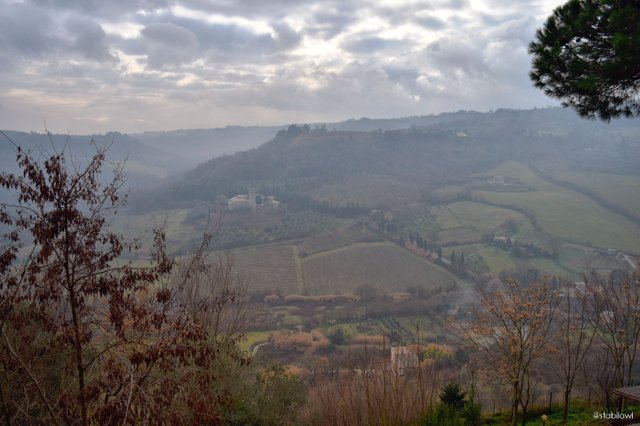
And this was the end of our two days stay at Orvieto. It was a truly amazing experience, to stay at a genuine Italian small town, to experience the rich history and the friendly locals, and to explore a place at a leisurely pace, all without the horde of tourists that we usually encounter in major tourist cities. We were glad to have put Orvieto on our itinerary, and I think you should too. So the next time you are visiting Rome, don’t forget to put aside a day or two to visit this magnificent town of Orvieto!
就这样,我们的奥尔维耶托两天游就到此为止。在古城里游玩夜宿真是特别的棒。在这里我们体验了意大利小镇的风情,认识到悠久的历史和当地文化,还感受到当地人的热情和友好。这里虽然没有罗马或威尼斯有名,可是却有着大城市没有的休闲和宁静。如果你准备去罗马,记得空出一两天来奥尔维耶托逛逛,感受一下真正的意大利吧!
一篇堪称完美的游记!可惜当年去罗马时没留出时间去奥尔维耶托。。。
谢谢你的夸奖!可以下次再去啊!
正有此意!
Congratulations! Your high quality travel content caught our attention and earned you a reward, in form of an upvote and resteem. Your work really stands out. Your article now has a chance to get curated and featured under the appropriate daily topic of our Travelfeed blog. Thank you for using #travelfeed
Thanks! I hope I can make it into your selected posts!
So many beautiful photos... I love them all
Thank you very much! Glad you liked it!
好看
谢谢啊!😊 要常来看看哈!
Really its true line
(The world is a book, and those who do not travel read only a page.)
Keep enjoy dear your life.
Its really beautifull place keep enjoy your life
Thanks, glad you liked it!
Amazing! I especially enjoyed the spelunking. I'm a huge spelunker. Beyond that photographing caves takes a good amount of skill.
I noticed you don't have any EXIF data in your post. Enjoy some EXIF Data for your Photo and a free upvote. Please let me know if this is useful to you. For more details, see my introduction Introducing Exifr
Wow.. awesome.. photos and your information are perfect.. thank you and good luck .. 👌👍👍
Thanks! Stay tuned for more photos and travel posts!
Your welcome.. 👍
wow amazing photography...... and perfect view.... it's like old city have a soul
It was like it have a soul indeed. Old cities like this have always captured my imagination, and being in one was really an awesome experience.
享受生活关注自然,人生需要多一些冒险和尝试,丰富的经历在年老时是一笔非常宝贵的精神财富。